#ratio proportion and variation formula
Explore tagged Tumblr posts
Text
Using Random-Maturity Arbitrage to Price Perpetual Futures
Using Random-Maturity Arbitrage to Price Perpetual Futures Traditional futures contracts have maturity dates, upon which the futures price converges to the spot price. In the cryptocurrency market, the most popular contracts do not have a maturity date. They're called perpetual contracts. Unlike fixed-maturity futures, perpetuals do not expire. This feature enhances the liquidity of the contract. Because they have no set expiration date, perpetuals are not guaranteed to converge to the spot price of their underlying asset at any given time, and the usual no-arbitrage pricing formulas do not apply. To minimize the gap between perpetual futures and spot prices, long position holders periodically pay short position holders a funding rate proportional to this gap, incentivizing trades that help narrow it. Typically, the funding rate is paid every eight hours and approximately equals the average futures-spot spread over the preceding eight hours. How do you price a perpetual contract, given that the usual no-arbitrage condition does not apply? Reference [1] proposed the use of random-maturity arbitrage to price perpetual futures. Basically, random-maturity arbitrage generalizes traditional arbitrage by allowing for a positive payoff at an uncertain future time. The authors also developed bounds for the random-maturity arbitrage price and used these bounds to construct an arbitrage strategy that delivered a high Sharpe ratio. They pointed out, In an ideal, frictionless world, we show that arbitrageurs would trade perpetual futures in such a way that a constant proportional relationship would hold between the futures price and the spot price. In the presence of trading costs, the deviation of the futures price from the spot would lie within a bound. Motivated by our theory, we empirically examine the comovement of the futures- spot spread across different cryptocurrencies and implement a theory-motivated arbitrage strategy. We find that this simple strategy yields substantial Sharpe ratios across various trading cost scenarios. The evidence supports our theoretical argument that perpetual futures-spot spreads exceeding trading costs represent a random-maturity arbitrage opportunity. Finally, we provide an explanation for the common comovement in futures-spot spreads across different crypto-currencies: arbitrageurs can only accommodate market demand if the price deviation exceeds trading costs. As a result, the overall sentiment in the futures market relative to the spot market is reflected in the spread. Our empirical findings suggest that past return momentum can account for a significant portion of the time-series variation in the futures-spot spread. An interesting conclusion of the paper is that overall sentiment in the futures market relative to the spot market is reflected in the spread. Empirical findings suggest that past return momentum accounts for a significant portion of the time-series variation in the futures-spot spread. Let us know what you think in the comments below or in the discussion forum. References [1] He, Songrun and Manela, Asaf and Ross, Omri and von Wachter, Victor, Fundamentals of Perpetual Futures (2022). https://ift.tt/VxgeXYU Post Source Here: Using Random-Maturity Arbitrage to Price Perpetual Futures via Harbourfront Technologies - Feed https://ift.tt/DqL3UTI June 08, 2025 at 09:12PM
0 notes
Text
Ready Mix Concrete Supplier

The Benefits of Choosing a Ready Mix Concrete Supplier In the construction industry, the materials used can make or break a project. Among these materials, concrete stands out as one of the most essential components for a wide variety of applications, from foundations and sidewalks to driveways and structural elements. When it comes to sourcing concrete, one of the most efficient and effective options is to partner with a ready mix concrete supplier. In this blog article, we will explore why you need or want a ready mix concrete supplier, the advantages of using their services, and how they can contribute to the overall success of your construction project. What is Ready Mix Concrete? Before diving into the benefits, it's essential to understand what ready mix concrete is. Ready mix concrete is a pre-mixed blend of cement, water, aggregates (sand, gravel, or crushed stone), and additives that are combined at a batching plant. This concrete is then delivered to construction sites in a freshly mixed state, ensuring that it is ready for immediate use. The process eliminates the need for on-site mixing, providing consistency in quality and performance. Reasons to Choose a Ready Mix Concrete Supplier
Consistency and Quality Control One of the primary advantages of using a ready mix concrete supplier is the consistency in the quality of the concrete produced. Unlike mixing concrete on-site, where variations in measurements can lead to inconsistencies, ready mix suppliers adhere to strict quality control standards. They utilize precise formulas and modern mixing equipment to ensure that each batch meets specified strength and durability requirements. This level of consistency is crucial for structural applications where safety and reliability are paramount.
Time Efficiency Time is often a critical factor in construction projects. Mixing concrete on-site can be time-consuming, especially if you need to calculate the correct ratios of materials and ensure that everything is mixed uniformly. By opting for a ready mix concrete supplier, you can save valuable time. The concrete is delivered to your site ready for use, allowing you to focus on other aspects of your project. This time efficiency can lead to significant cost savings, particularly in larger projects where delays can escalate expenses.
Reduced Labor Costs Using a ready mix concrete supplier can also help reduce labor costs. Mixing concrete on-site requires skilled labor to ensure the correct proportions and mixing techniques. With ready mix concrete, the need for on-site mixing labor is minimized. Instead, the delivery team handles the transportation and unloading, allowing your construction crew to dedicate their efforts to other essential tasks, thus improving overall productivity.
Flexibility and Customization Every construction project is unique, and sometimes standard concrete mixes may not meet specific requirements. Ready mix concrete suppliers offer a wide range of mix designs, allowing you to customize the concrete to suit your project’s needs. Whether you need a high-strength mix for a commercial building or a decorative finish for a residential driveway, suppliers can tailor their offerings to fit your specifications. This flexibility ensures that your concrete is well-suited for its intended application.
Convenient Delivery Options Ready mix concrete suppliers typically offer a range of delivery options, including scheduled deliveries, same-day service, and bulk deliveries. This flexibility allows you to plan your construction activities effectively. With timely delivery, you can ensure that your project stays on schedule, reducing the risk of delays and associated costs. Moreover, many suppliers utilize modern fleet vehicles equipped with advanced technology to monitor delivery conditions, ensuring that your concrete arrives in optimal condition.
Environmental Benefits Sustainability is becoming an increasingly important consideration in the construction industry. Ready mix concrete suppliers often incorporate environmentally friendly practices in their operations. Many suppliers use recycled materials in their mixes, reducing the need for virgin resources and minimizing waste. Additionally, by sourcing concrete locally, you can reduce your project's carbon footprint associated with transportation. Some suppliers even offer green concrete options, which feature additives that enhance sustainability and performance.
Technical Expertise and Support Partnering with a ready mix concrete supplier means gaining access to their expertise and technical knowledge. Many suppliers employ engineers and technical professionals who can provide guidance on mix selection, design, and best practices for concrete placement. This support can be invaluable in ensuring that your project meets all necessary codes and standards. Furthermore, if any issues arise during the project, your supplier can offer solutions and adjustments to the mix to address the challenges.
Improved Worksite Safety Safety is a critical concern on any construction site. Mixing concrete on-site can pose risks, such as equipment accidents or material spills. By utilizing a ready mix concrete supplier, you can minimize these risks. The controlled environment of a batching plant reduces the chances of accidents associated with manual mixing. Additionally, the delivery process is handled by trained professionals, further enhancing the safety of your worksite. Conclusion In conclusion, choosing a ready mix concrete supplier offers numerous benefits that can significantly enhance the success of your construction project. From ensuring consistent quality and saving time to providing flexibility and reducing labor costs, the advantages are clear. Additionally, the expertise and support offered by suppliers can guide you through the complexities of concrete use, ensuring that your project meets its goals efficiently and safely. Whether you’re a contractor, architect, or homeowner planning a construction project, partnering with a ready mix concrete supplier is a wise decision. It allows you to focus on what you do best while leaving the complexities of concrete production and delivery to the experts. Embrace the convenience, quality, and reliability of ready mix concrete, and watch your construction dreams come to life with confidence.
readymixconcretesupplier #readymixconcrete #readymix #concrete #readymixedconcrete #covid #concretepumping #concreteconstruction #concretecontractor #odessatexas #odessatx #midlandtexas #midlandtx #westtexas #odessa #permianbasin #texas #coffee #midland
1 note
·
View note
Text
The Benefits of Using Ready Mix Concrete in Karachi
As Karachi continues to grow as Pakistan’s economic powerhouse, construction is a booming industry that plays a pivotal role in the city’s development. Whether it's high-rise buildings, residential homes, commercial spaces, or infrastructure projects, choosing the right materials for construction is crucial. Among these materials, Ready Mix Concrete in Karachi stands out as one of the most essential components for modern construction projects. In this article, we will explore the numerous benefits of using Ready Mix Concrete Karachi and why it's the best choice for construction projects in the city.
What is Ready Mix Concrete?
Before diving into the benefits, it's essential to understand what ready mix concrete (RMC) is. Ready mix concrete is a type of concrete that is manufactured in a batching plant, mixed to specific proportions, and then transported to a construction site. The concrete is delivered in ready-to-use form, ensuring uniformity and high quality throughout.
Instead of mixing concrete on-site, which is time-consuming and labor-intensive, ready mix concrete is prepared by professionals who control the mix ratios precisely, guaranteeing consistent performance. It has revolutionized the construction industry, particularly in bustling cities like Karachi, where efficiency and quality are paramount.

Benefits of Using Ready Mix Concrete in Karachi
Consistency and High Quality One of the biggest advantages of using Ready Mix Concrete Karachi is the consistent quality that is hard to achieve with on-site mixing. RMC is prepared in a controlled environment, where every batch is carefully mixed following a precise formula. This ensures that the concrete has uniform strength, durability, and consistency throughout the project.On-site mixing, on the other hand, may lead to variations in the mix due to human error or environmental factors, compromising the quality of the final product. Using ready mix concrete minimizes these risks, offering superior strength and durability.
Time-Efficient Construction projects in a bustling city like Karachi often face tight deadlines, and on-time delivery is critical. Ready mix concrete offers significant time savings compared to mixing concrete on-site. Since the concrete is pre-mixed at a plant and delivered directly to the site, the construction team can focus on other aspects of the project, rather than spending valuable time preparing concrete.The delivery system for ready mix concrete is highly efficient. It arrives ready for pouring, so you don’t need to worry about the laborious process of mixing materials on-site, which can lead to delays and higher labor costs.
Cost-Effective Solution While the upfront cost of Ready Mix Concrete Karachi might seem higher than on-site mixing, it ultimately proves more cost-effective. When you factor in the cost of materials, labor, transportation, and waste generated by on-site mixing, RMC offers significant savings.Additionally, the high quality of ready mix concrete means fewer repairs and less maintenance are needed in the future. In the long run, RMC provides a stronger and more durable solution, reducing the total cost of ownership.
Reduced Waste With traditional on-site concrete mixing, there's often a lot of material waste due to inaccurate mixing proportions and over-preparation. Ready mix concrete is prepared in exact quantities, which significantly reduces material waste. For construction projects in Karachi, where material management and waste disposal can be logistical challenges, RMC offers a more sustainable solution.The precise mixing process ensures that no excess concrete is prepared, thereby lowering the overall material cost and reducing the environmental impact.
Environmental Benefits In addition to minimizing waste, Ready Mix Concrete Karachi also contributes to a greener construction industry. Ready mix concrete is produced in batches that can be tailored to meet the specific needs of each project, reducing the amount of surplus material that ends up in landfills. Furthermore, batch plants typically use modern technologies and energy-efficient methods to produce concrete, further reducing the environmental footprint.For environmentally conscious builders and developers in Karachi, choosing ready mix concrete is an eco-friendly option that helps reduce the construction industry's carbon footprint.
Enhanced Construction Speed For large-scale construction projects in Karachi, speed is of the essence. Delays in material delivery or preparation can derail a project’s timeline. Ready mix concrete can be delivered in bulk quantities, ensuring that construction activities continue without interruptions. The consistency and reliability of RMC mean that contractors can complete tasks faster, leading to earlier project completion.When using ready mix concrete, contractors avoid bottlenecks that often occur with on-site mixing, such as delays caused by labor shortages, material availability, or weather conditions.
Versatility Ready mix concrete is highly versatile, making it suitable for various applications. Whether you’re working on residential homes, commercial buildings, infrastructure projects, or decorative concrete elements, RMC can be customized to meet specific project requirements. Additives can be included in the mix to improve its workability, strength, or even appearance.In Karachi, where different types of construction projects are always underway, having access to a versatile building material like RMC is incredibly beneficial.
Less Supervision Required Using ready mix concrete requires less supervision and quality control on-site. Since RMC is manufactured under strict conditions in a batching plant, project managers and site supervisors can be confident in the quality of the material being delivered. This reduces the need for constant oversight and inspections, freeing up valuable resources to focus on other aspects of the project.
Improved Safety Mixing concrete on-site can expose workers to various hazards, such as handling heavy materials, working with cement dust, and operating dangerous machinery. Ready mix concrete eliminates many of these risks, as the mixing process is done off-site in a controlled environment. Once the concrete is delivered, workers only need to handle the pouring and finishing stages, reducing the risk of accidents and improving overall site safety.In a fast-paced city like Karachi, where construction projects often take place in busy areas, reducing on-site risks is crucial for maintaining a safe working environment.
Ideal for Karachi’s Weather Conditions Karachi’s weather conditions, which can vary between extremely hot summers and monsoon rains, make it challenging to ensure proper concrete mixing and curing on-site. Ready mix concrete is formulated in a controlled environment, ensuring optimal performance despite Karachi’s changing climate.Since the mixing is done off-site, the construction team doesn’t have to worry about the weather affecting the mixing process. Moreover, ready mix concrete has a shorter setting time, which helps avoid potential issues caused by Karachi's weather.
Why Allied Materials is the Right Choice for Ready Mix Concrete in Karachi
Choosing a reliable supplier for ready mix concrete is crucial to the success of your construction project. Allied Materials, a leading name in Ready Mix Concrete Karachi, has a proven track record of delivering high-quality concrete solutions across the city. Whether you’re working on a small residential project or a large-scale commercial development, Allied Materials can meet your needs with precision and professionalism.
Their ready mix concrete services are known for:
Superior Quality: Every batch is prepared to the highest standards, ensuring consistent strength and durability.
Timely Delivery: With a fleet of modern transit mixers, Allied Materials ensures that your concrete arrives on time, ready for use.
Customized Solutions: They offer a range of mix designs tailored to your specific project requirements.
Expert Support: Their team of professionals is always on hand to provide guidance and support, ensuring your project runs smoothly from start to finish.
For those looking for the best Ready Mix Concrete Karachi, Allied Materials provides an unbeatable combination of quality, service, and affordability. You can learn more about their services by visiting their official website.
Conclusion
In a fast-growing city like Karachi, construction projects require materials that are not only reliable but also efficient and cost-effective. Ready Mix Concrete Karachi is the perfect solution for a wide range of construction needs, offering high quality, consistency, and time savings. By choosing Allied Materials as your trusted supplier, you ensure that your project benefits from top-notch materials and services, guaranteeing success from start to finish.
0 notes
Text
Complete Guide to 76 Popular Stock Market Terms: Master the Lingo Today!

The stock market can seem intimidating, especially with all the jargon investors throw around. If you've ever felt lost hearing terms like "bull market," "P/E ratio," or "market sentiment," you’re not alone. This guide is here to simplify 76 essential stock market terms, providing clear definitions, real-world examples, and actionable insights.
Let’s decode the stock market together!
1. Why Understanding Stock Market Terms Matters
Investing in the stock market is not just about buying and selling shares; it’s about making informed decisions. Knowing the terminology can:
Help you analyze opportunities.
Make financial news comprehensible.
Protect you from potential scams.
For example, a lack of understanding of terms like "stop-loss" has caused many retail investors to lose money in volatile markets like India’s Nifty50.
2. Beginner Stock Market Terms You Must Know
What is a Stock?
A stock represents ownership in a company. When you buy a share, you own a small piece of the company.
Example: If you buy 10 shares of Reliance Industries, you own a portion of the company proportional to its total outstanding shares.
Pro Tip: Track Indian stocks using tools like Strike.money to stay updated on market movements.
What are Dividends?
A dividend is a company’s way of sharing profits with its shareholders.
Example: TCS paid ₹90 per share in dividends in FY2023.
Key Tip: Dividend-paying stocks like HDFC Bank and Infosys are often favored by long-term investors.
What is an IPO?

An Initial Public Offering (IPO) is when a private company offers its shares to the public for the first time.
Example: Zomato's IPO in 2021 was one of India’s most talked-about stock market events.
Interesting Stat: Over 70 IPOs were launched in India in 2022, raising ₹1.6 lakh crore.
Market Cap Simplified
Market capitalization (market cap) is the total value of a company’s outstanding shares.
Formula: Market Cap = Share Price × Total Shares.
Example: Reliance Industries’ market cap is ₹16.5 lakh crore, making it India’s most valuable company.
What is Nifty50 and Sensex?

These are major indices in India that track the performance of the top companies:
Nifty50: Tracks 50 large-cap companies listed on the NSE.
Sensex: Tracks 30 top-performing companies on the BSE.
3. Who Are the Key Players in the Stock Market?
Stock Exchanges: NSE and BSE
NSE (National Stock Exchange): India's largest stock exchange by trading volume.
BSE (Bombay Stock Exchange): Asia’s oldest stock exchange.
Securities and Exchange Board of India (SEBI)
SEBI regulates India’s financial markets to ensure transparency and protect investors.
Example: SEBI introduced rules for IPO allotment to make the process fairer for retail investors.
Key Indices You Should Follow
Indices like Nifty Midcap 100 and Bank Nifty help track sectoral or market-cap-specific performance.
Example: Bank Nifty includes top banking stocks like ICICI Bank and Axis Bank.
4. Stock Market Trends and Strategies
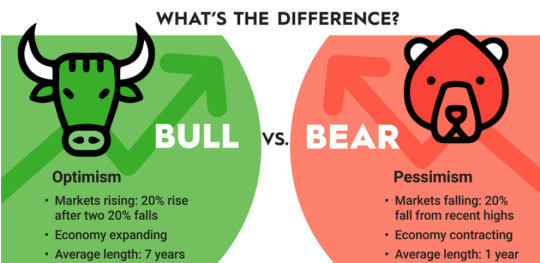
What is a Bull Market?
A bull market occurs when stock prices are rising for an extended period.
Example: The Indian stock market saw a bull run from 2020 to 2022, with Nifty50 doubling in value.
What is a Bear Market?
A bear market is the opposite, characterized by declining stock prices.
Example: During the 2008 global financial crisis, Sensex lost over 50% of its value.
Understanding Market Sentiment
Market sentiment reflects the overall attitude of investors.
Pro Tip: Tools like Strike.money can help gauge market sentiment using real-time analytics.
Volatility in Action
Volatility refers to the degree of variation in stock prices.
Example: Stocks like Adani Enterprises are known for high volatility.
5. Advanced Stock Market Concepts
What is Short Selling?
Short selling involves selling borrowed shares, hoping to buy them back at a lower price.
Example: During the Hindenburg-Adani saga, short sellers profited as Adani stocks plummeted.
What are Derivatives?
Derivatives are financial contracts whose value depends on an underlying asset like stocks or indices.
Example: Nifty Futures allow investors to speculate on the future value of the Nifty50 index.
Arbitrage: Risk-Free Profit?
Arbitrage involves profiting from price differences between markets.
Example: Buying a stock on BSE and selling it on NSE if there’s a price gap.
6. Investment Vehicles to Grow Your Wealth
Mutual Funds vs. ETFs
Mutual Funds: Actively managed by fund managers.
ETFs: Passive funds tracking an index like Nifty50.
Example: Nippon India ETF tracks the Nifty50.
What are Index Funds?
Index funds mirror the performance of indices like Nifty50 or Sensex.
Pro Tip: They are great for beginners due to low costs and diversification.
Real Estate Investment Trusts (REITs)
REITs let you invest in real estate without owning property.
Example: Embassy REIT is India’s largest listed REIT.
7. Must-Know Financial Ratios
P/E Ratio
The Price-to-Earnings (P/E) ratio tells you how much investors are willing to pay for ₹1 of earnings.
Formula: P/E Ratio = Market Price / Earnings Per Share.
Example: A P/E ratio of 25 means investors are paying ₹25 for ₹1 of earnings.
Return on Equity (ROE)
ROE measures a company’s profitability relative to shareholder equity.
Example: HDFC Bank has consistently delivered an ROE above 15%.
Dividend Yield
Dividend yield shows how much a company pays in dividends relative to its stock price.
Formula: Dividend Yield = Dividend / Share Price × 100.
Example: Coal India offers one of the highest dividend yields in India.
8. FAQs to Simplify Complex Terms
What is the Difference Between a Stock and a Share?
A stock refers to ownership in one or more companies.
A share is a single unit of ownership in a company.
What is an FII vs. DII?
Foreign Institutional Investors (FIIs): Invest in Indian markets from abroad.
Domestic Institutional Investors (DIIs): Indian entities like LIC that invest locally.
How Does Stop-Loss Work?
A stop-loss is a pre-set price to sell a stock to minimize losses.
Example: If you buy TCS at ₹3,000, you might set a stop-loss at ₹2,800.
9. Takeaways and Tools for Smarter Investing
Recap of Key Concepts
Understanding these terms equips you to navigate the stock market confidently. Remember:
Use tools like Strike.money for analytics and tracking.
Keep updated with SEBI regulations.
Additional Resources
Books: The Intelligent Investor by Benjamin Graham.
Courses: NSE’s Certification in Financial Markets (NCFM).
Blogs: Follow expert analysis on Economic Times and Moneycontrol.
Final Tip: Stay Consistent

The stock market rewards knowledge and patience. Start small, stay informed, and use tools like Strike.money to optimize your trading journey.
Mastering stock market terms is your first step toward financial independence. Let’s grow together!
0 notes
Link
Ratio proportion and variation problems with solutions, formulas, Properties with quantitative aptitude shortcuts for all Competitive Exams
#ratio proportion and variation tricks#Ratio Proportion and Variation#ratio proportion and variation formula#ratio proportion and variation aptitude#Ratio and Proportion – Concepts Properties#allmathtricks
0 notes
Text
Continuation of the earlier post.
In the earlier post, I was talking about the great mathematicians of the world. In this post, I am gonna talk about - Archimedes and Pythagoras.
ARCHIMEDES
Archimedes was the most-famous mathematician and inventor in ancient Greece. Archimedes is especially important for his discovery of the relation between the surface and volume of a sphere and its circumscribing cylinder.He is known for his formulation of a hydrostatic principle (known as Archimedes’ principle) and a device for raising water, still used in developing countries, known as the Archimedes screw. Archimedes probably spent some time in Egypt early in his career, but he resided for most of his life in Syracuse, the principal Greek city-state in Sicily, where he was on intimate terms with its king, Hieron II. Archimedes published his works in the form of correspondence with the principal mathematicians of his time, including the Alexandrian scholars Conon of Samos and Eratosthenes of Cyrene. He played an important role in the defense of Syracuse against the siege laid by the Romans in 213 BCE by constructing war machines so effective that they long delayed the capture of the city. When Syracuse eventually fell to the Roman general Marcus Claudius Marcellus in the autumn of 212 or spring of 211 BCE, Archimedes was killed in the sack of the city.
TOP QUESTIONS
What was Archimedes’ profession? When and how did it begin?
What accomplishments was Archimedes known for?
What specific works did Archimedes create?
What is known about Archimedes’ family, personal life, and early life?
Where was Archimedes born? How and where did he die?
Study how turning a helix enclosed in a circular pipe raises water in an Archimedes screw
Study how turning a helix enclosed in a circular pipe raises water in an Archimedes screw
An animation of Archimedes screw.
Encyclopædia Britannica, Inc.
See all videos for this article
Far more details survive about the life of Archimedes than about any other ancient scientist, but they are largely anecdotal, reflecting the impression that his mechanical genius made on the popular imagination. Thus, he is credited with inventing the Archimedes screw, and he is supposed to have made two “spheres” that Marcellus took back to Rome—one a star globe and the other a device (the details of which are uncertain) for mechanically representing the motions of the Sun, the Moon, and the planets. The story that he determined the proportion of gold and silver in a wreath made for Hieron by weighing it in water is probably true, but the version that has him leaping from the bath in which he supposedly got the idea and running naked through the streets shouting “Heurēka!” (“I have found it!”) is popular embellishment. Equally apocryphal are the stories that he used a huge array of mirrors to burn the Roman ships besieging Syracuse; that he said, “Give me a place to stand and I will move the Earth”; and that a Roman soldier killed him because he refused to leave his mathematical diagrams—although all are popular reflections of his real interest in catoptrics (the branch of optics dealing with the reflection of light from mirrors, plane or curved), mechanics, and pure mathematics.
According to Plutarch (c. 46–119 CE), Archimedes had so low an opinion of the kind of practical invention at which he excelled and to which he owed his contemporary fame that he left no written work on such subjects. While it is true that—apart from a dubious reference to a treatise, “On Sphere-Making”—all of his known works were of a theoretical character, his interest in mechanics nevertheless deeply influenced his mathematical thinking. Not only did he write works on theoretical mechanics and hydrostatics, but his treatise Method Concerning Mechanical Theorems shows that he used mechanical reasoning as a heuristic device for the discovery of new mathematical theorems.
Get exclusive access to content from our 1768 First Edition with your subscription.
Subscribe today
His Works
There are nine extant treatises by Archimedes in Greek. The principal results in On the Sphere and Cylinder (in two books) are that the surface area of any sphere of radius r is four times that of its greatest circle (in modern notation, S = 4πr2) and that the volume of a sphere is two-thirds that of the cylinder in which it is inscribed (leading immediately to the formula for the volume, V = 4/3πr3). Archimedes was proud enough of the latter discovery to leave instructions for his tomb to be marked with a sphere inscribed in a cylinder. Marcus Tullius Cicero (106–43 BCE) found the tomb, overgrown with vegetation, a century and a half after Archimedes’ death.
sphere with circumscribing cylinder
sphere with circumscribing cylinder
The volume of a sphere is 4πr3/3, and the volume of the circumscribing cylinder is 2πr3. The surface area of a sphere is 4πr2, and the surface area of the circumscribing cylinder is 6πr2. Hence, any sphere has both two-thirds the volume and two-thirds the surface area of its circumscribing cylinder.
Encyclopædia Britannica, Inc.
Measurement of the Circle is a fragment of a longer work in which π (pi), the ratio of the circumference to the diameter of a circle, is shown to lie between the limits of 3 10/71 and 3 1/7. Archimedes’ approach to determining π, which consists of inscribing and circumscribing regular polygons with a large number of sides, was followed by everyone until the development of infinite series expansions in India during the 15th century and in Europe during the 17th century. That work also contains accurate approximations (expressed as ratios of integers) to the square roots of 3 and several large numbers.
On Conoids and Spheroids deals with determining the volumes of the segments of solids formed by the revolution of a conic section (circle, ellipse, parabola, or hyperbola) about its axis. In modern terms, those are problems of integration. (See calculus.) On Spirals develops many properties of tangents to, and areas associated with, the spiral of Archimedes—i.e., the locus of a point moving with uniform speed along a straight line that itself is rotating with uniform speed about a fixed point. It was one of only a few curves beyond the straight line and the conic sections known in antiquity.
On the Equilibrium of Planes (or Centres of Gravity of Planes; in two books) is mainly concerned with establishing the centres of gravity of various rectilinear plane figures and segments of the parabola and the paraboloid. The first book purports to establish the “law of the lever” (magnitudes balance at distances from the fulcrum in inverse ratio to their weights), and it is mainly on the basis of that treatise that Archimedes has been called the founder of theoretical mechanics. Much of that book, however, is undoubtedly not authentic, consisting as it does of inept later additions or reworkings, and it seems likely that the basic principle of the law of the lever and—possibly—the concept of the centre of gravity were established on a mathematical basis by scholars earlier than Archimedes. His contribution was rather to extend those concepts to conic sections.
Quadrature of the Parabola demonstrates, first by “mechanical” means (as in Method, discussed below) and then by conventional geometric methods, that the area of any segment of a parabola is 4/3 of the area of the triangle having the same base and height as that segment. That is, again, a problem in integration.
The Sand-Reckoner is a small treatise that is a jeu d’esprit written for the layman—it is addressed to Gelon, son of Hieron—that nevertheless contains some profoundly original mathematics. Its object is to remedy the inadequacies of the Greek numerical notation system by showing how to express a huge number—the number of grains of sand that it would take to fill the whole of the universe. What Archimedes does, in effect, is to create a place-value system of notation, with a base of 100,000,000. (That was apparently a completely original idea, since he had no knowledge of the contemporary Babylonian place-value system with base 60.) The work is also of interest because it gives the most detailed surviving description of the heliocentric system of Aristarchus of Samos (c. 310–230 BCE) and because it contains an account of an ingenious procedure that Archimedes used to determine the Sun’s apparent diameter by observation with an instrument.
Method Concerning Mechanical Theorems describes a process of discovery in mathematics. It is the sole surviving work from antiquity, and one of the few from any period, that deals with this topic. In it Archimedes recounts how he used a “mechanical” method to arrive at some of his key discoveries, including the area of a parabolic segment and the surface area and volume of a sphere. The technique consists of dividing each of two figures into an infinite but equal number of infinitesimally thin strips, then “weighing” each corresponding pair of these strips against each other on a notional balance to obtain the ratio of the two original figures. Archimedes emphasizes that, though useful as a heuristic method, this procedure does not constitute a rigorous proof.
On Floating Bodies (in two books) survives only partly in Greek, the rest in medieval Latin translation from the Greek. It is the first known work on hydrostatics, of which Archimedes is recognized as the founder. Its purpose is to determine the positions that various solids will assume when floating in a fluid, according to their form and the variation in their specific gravities. In the first book various general principles are established, notably what has come to be known as Archimedes’ principle: a solid denser than a fluid will, when immersed in that fluid, be lighter by the weight of the fluid it displaces. The second book is a mathematical tour de force unmatched in antiquity and rarely equaled since. In it Archimedes determines the different positions of stability that a right paraboloid of revolution assumes when floating in a fluid of greater specific gravity, according to geometric and hydrostatic variations.
Archimedes is known, from references of later authors, to have written a number of other works that have not survived. Of particular interest are treatises on catoptrics, in which he discussed, among other things, the phenomenon of refraction; on the 13 semiregular (Archimedean) polyhedra (those bodies bounded by regular polygons, not necessarily all of the same type, that can be inscribed in a sphere); and the “Cattle Problem” (preserved in a Greek epigram), which poses a problem in indeterminate analysis, with eight unknowns. In addition to those, there survive several works in Arabic translation ascribed to Archimedes that cannot have been composed by him in their present form, although they may contain “Archimedean” elements. Those include a work on inscribing the regular heptagon in a circle; a collection of lemmas (propositions assumed to be true that are used to prove a theorem) and a book, On Touching Circles, both having to do with elementary plane geometry; and the Stomachion (parts of which also survive in Greek), dealing with a square divided into 14 pieces for a game or puzzle.
Archimedes’ mathematical proofs and presentation exhibit great boldness and originality of thought on the one hand and extreme rigour on the other, meeting the highest standards of contemporary geometry. While the Method shows that he arrived at the formulas for the surface area and volume of a sphere by “mechanical” reasoning involving infinitesimals, in his actual proofs of the results in Sphere and Cylinder he uses only the rigorous methods of successive finite approximation that had been invented by Eudoxus of Cnidus in the 4th century BCE. These methods, of which Archimedes was a master, are the standard procedure in all his works on higher geometry that deal with proving results about areas and volumes. Their mathematical rigour stands in strong contrast to the “proofs” of the first practitioners of integral calculus in the 17th century, when infinitesimals were reintroduced into mathematics. Yet Archimedes’ results are no less impressive than theirs. The same freedom from conventional ways of thinking is apparent in the arithmetical field in Sand-Reckoner, which shows a deep understanding of the nature of the numerical system.
In antiquity Archimedes was also known as an outstanding astronomer: his observations of solstices were used by Hipparchus (flourished c. 140 BCE), the foremost ancient astronomer. Very little is known of this side of Archimedes’ activity, although Sand-Reckoner reveals his keen astronomical interest and practical observational ability. There has, however, been handed down a set of numbers attributed to him giving the distances of the various heavenly bodies from Earth, which has been shown to be based not on observed astronomical data but on a “Pythagorean” theory associating the spatial intervals between the planets with musical intervals. Surprising though it is to find those metaphysical speculations in the work of a practicing astronomer, there is good reason to believe that their attribution to Archimedes is correct.

PYTHAGORAS
Pythagoras of Samos[a] (c. 570 – c. 495 BC)[b] was an ancient Ionian Greek philosopher and the eponymous founder of Pythagoreanism. His political and religious teachings were well known in Magna Graecia and influenced the philosophies of Plato, Aristotle, and, through them, Western philosophy. Knowledge of his life is clouded by legend, but he appears to have been the son of Mnesarchus, a gem-engraver on the island of Samos. Modern scholars disagree regarding Pythagoras's education and influences, but they do agree that, around 530 BC, he travelled to Croton in southern Italy, where he founded a school in which initiates were sworn to secrecy and lived a communal, ascetic lifestyle. This lifestyle entailed a number of dietary prohibitions, traditionally said to have included vegetarianism, although modern scholars doubt that he ever advocated for complete vegetarianism.
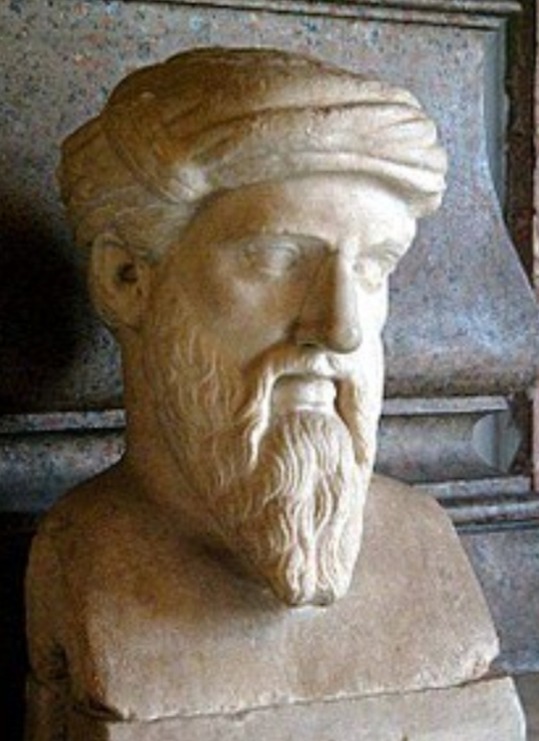
In the next post, I will be talking about ramanujan and shakuntala devi.
Follow me, stay tuned, next post will be uploaded soon.
1 note
·
View note
Text
ncert solutions for class 8 maths
NCERT Solutions for class 8 Maths
in case if you are looking for accurate, comprehensive and free ncert solutions for class 8 maths then you are at very right place. These ncert solutions for class 8 maths are available in the PDF format, which can be easily shared and accessed among friends. The diligent efforts of faculties at Entrancei have made sure the best of all solutions are available for students.
In order to make the learning process very easy, the students need to just go throw the study material. These ncert solutions for class 8 maths are the best tool for a quick revision of your concepts. The complete syllabus has been broke down into various parts in the manner of chapters. Students need to just sign up at Entracei. The categorization of chapters is made below
Ø Chapter 1: Rational Number
This chapter of ncert solutions for class 8 maths helps the students with giving them a deep understanding of number system and rational numbers.
Ø Chapter2: Linear Equations in One Variable
This chapter of ncert solutions for class 8 maths helps the students in getting acquainted with the method of solving contextual problems based upon linear equations
Ø Chapter 3: Understanding Quadrilaterals
This chapter of ncert solutions for class 8 maths helps the students with knowledge of angles and their sum. This chapter helps the students with convex, concave and parallelograms.
Ø Chapter 4: Practical Geometry
This chapter of ncert solutions for class 8 maths helps the students with enhancing their knowledge regarding rhombus, parallelograms, squares, and rectangles.
Ø Chapter 5: Data Handling
This chapter enhances students’ knowledge with the method of representing data in the form of bar graphs and charts.
Ø Chapter 6: Square and Square roots
This chapter of ncert solutions for class 8 maths teaches the students in solving critical square roots through factor method and division method
Ø Chapter 7: Cube and Cube roots
This method presents a stepwise representation of methods to determine cube roots.
Ø Chapter 8: Comparing Quantities
This chapter of ncert solutions for class 8 maths helps the students with unit quantities like percentage, ratio, sales tax, and compound interests.
Ø Chapter 9: Algebraic expressions and Identities
This chapter of ncert solutions for class 8 maths helps the students in solving algebraic expression with addition, subtraction, division, and multiplication.
Ø Chapter 10: Visualising solid shapes
This chapter of ncert solutions for class 8 maths helps the students regarding 3D objects and their plotting on map.
Ø Chapter 11: Mensuration
This chapter of ncert solutions for class 8 maths helps the students in determining areas of polygon and trapezium.
Ø Chapter 12: Exponents and powers
This chapter of ncert solutions for class 8 maths helps the students regarding the integers in the number system.
Ø Chapter 13: Direct and Inverse Proportions
This chapter of ncert solutions for class 8 maths helps the students regarding the variation which is direct and in-direct quantities in NCERT book.
Ø Chapter 14: Factorization
This chapter helps the students in enhancing their concepts associated with algebraic identities and factorization.
Ø Chapter 15: Introduction to Graphs
This chapter of ncert solutions for class 8 maths helps the students reading numbers, perimeters, and length of square graphs.
Ø Chapter 16: Playing with numbers
This chapter of ncert solutions for class 8 maths is more of like a fun game where students need to plot 2 digits and 3 digit number from the puzzles.
Why ncert solutions for class 8 maths at Entancei
Ø Since maths has been crucial in building strong foundation, we make sure you get the best of all.
Ø The ncert solutions for class 8 maths are up-to-date and as per the latest NCERT regulations
Ø The expert provided ncert solutions for class 8 maths is sufficient to score great marks in Examination
Ø While solving the NCERT class 8 maths the most important think you required is maths formula. Check out all maths formula in one page
1 note
·
View note
Text
Stinger ↠ Drinks Up History As Crème de la Crème

High Society's After Dinner After-Party
A Stinger is a classic cocktail (of sorts) mixed with Cognac and white crème de menthe.* Perceived as an upper class after dinner drink if you will, its mint flavor has deceived many with ordinary brandy as their swill.

How To Make The Perfect Stinger
Stinger Cocktail Recipe:
1 ½ oz brandy or Cognac
½ oz white creme de menthe
1 mint leaf for garnish
Add to a cocktail shaker with ice. Shake ingredients thoroughly. Strain into a chilled glass and garnish with a mint leaf.
Many Stinger drink variations call for a lower ratio of Cognac to liqueur of say 2:1 or even lower. If you're unsure, its easy to start with that recipe and then adjust to taste by adding more brandy to stiffen the spirits if desired. Or, vice versa.
History of the Stinger Drink Recipe
The Backstory - Let Me In, I'm Filthy RICH!
The Stinger has long been associated with social status, which itself was once defined by the Vanderbilts who symbolized American Royalty during the Gilded Age. Patriarch Cornelius "Commodore" Vanderbilt built the family business from scratch by turning a $100 loan from his mother into a $100 million fortune before his death in 1877.
But, his was new money ...
And to be truly accepted into the upper echelons of 'Society' you had to be on Caroline Astor and Ward McAllister's list of the 400 people who were considered fashionable. Old money dominated the elite New York socialite crowd back then and Lina thought railroad riches were distasteful.
Often identified, qualified and then picked from the Social Register, members of the aristocracy lead the way in a clash of old money versus new money struggling for acceptance in the Social 400. This meant Alva, wife of the Commodore's grandson William Kissam Vanderbilt, would have to find a new way in.
She decided to flaunt her wealth and make a list of her own.†
It all started by building an opulent mansion on Fifth Avenue followed by a lavish housewarming party hyped in the press and held on March 26, 1883. Her exclusive guest list included invitations to all of society's highest ranking members along with a select group of young debutantes with one notable exception, Mrs. Astor's daughter Carrie.
Social customs dictated that Miss Astor couldn't be invited since her mother had never visited the Vanderbilt home. Or so Alva claimed.
As a result, Mrs. Astor came calling and the Astors' invitations arrived the next day. A reciprocal request to attend the Astor's upcoming annual ball meant formal acceptance of the Vanderbilts into New York society's upper echelon.
Guess it pays to have a plan.
4th Generation Vanderbilt Mixology
Fast forward a few decades and it was time to check in to see how things were going inside The 400.
After inheriting over ten million dollars and then another five when his brother Alfred died a hero aboard the RMS Lusitania in WWI, Reginald Claypoole Vanderbilt was living it up as an equestrian down on the Sandy Point Farm in Portsmouth, Rhode Island.‡ With a reputation as a playboy and avid gambler, Reggie was also famous for his country estate's "home bar."
Modeled after one in the William the Conqueror tavern in the seaside resort town of Deauville, France in the Calvados department of Normandy, it was spectacular and a status symbol like no other. What better way to celebrate the good life than a round of drinks among friends in grand style?
Long the stuff of legend (reputed to suck down lots at his favorite NY speakeasy, The Colony), this 1923 article made the scuttlebutt official and forever associated Reginald with his specialty behind the bar, the Stinger.1 He fancied himself an expert bartender and did everything from the squeezing and the shaking himself. That included the serving, even though he had servants.
So, Mr. Vanderbilt is largely credited with making the Stinger acceptable as a cocktail for other occasions too including morning, noon and nightcap apparently. In the 1957 musical comedy High Society for example, Bing Crosby heads to the butler's pantry, one of many bars in the movie's mansions, and hands a morning drink to Grace Kelly as “doctor's orders” after a long night of champagne and wine. Asked what it is, he said:
Oh, just the juice of a few fresh flowers called a Stinger ... removes the sting.
This drink has been in the movies outside of the upper crust of high society as well. Other notable featured film and TV appearances include The Bishop's Wife (1947), Kiss Them For Me (1957), The Apartment (1960), Gorky Park (1983) and Mad Men season one episode "Nixon v. Kennedy," set in 1960 along with season three episode two "Love Among the Ruins," set in 1963.
Stinger Drink Timeline with Related Recipe Milestones
Nibbling Along - But Not Quite A Bite
Prior to actually being stung, there was definitely a "sting in the air." Several recipe formulations pre-dated the soon to be Stinger standard that could be classified as iterations or similar drinks like those listed below, but were left in the timeline to illustrate the progression.
1892 The Judge - It called for a 2:1 ratio of brandy to crème de menthe along with a few dashes of gum syrup to sweeten things up. Sound familiar?
The Paymaster - Same proportions as above with bitters replacing the sweetener. Plus, a lemon-peel garnish on the glass brim.2
1895 Brant Cocktail - A renamed Paymaster drink with Angostura bitters and white crème de menthe called out specifically as ingredients.3
1900 Ice Trust Cocktail - Eight years later, the "Only William" of lower Broadway, who created The Paymaster and The Judge drinks above, decided equal parts plain was the perfect potion.4
Finally Stung - A Cocktail Chronology
1909 The Stinger - William T. "Cocktail Bill" Boothby, San Francisco bartender extraordinaire, is said to have left a note tucked into the back of one of his earlier books supposedly for possible inclusion in a later edition. In it he credits J. C. O'Conner, the proprietor of the "handsomest cafe for gentlemen in the world," located on the corner of Market and Eddy Streets in S. F., Calif.
Mr. O'Conner's formula stiffens the predecessors with a 3:1 ratio and caters to those with more expensive taste by specifying Cognac over ordinary brandy. Its shaken and served cold in a sherry glass. No garnish.
As for the date, its sometime after 1909 since his establishment didn't exist prior. Just exactly how long after is unknown and open to debate.5
1912 1st bartending book to actually print the Stinger recipe—maybe. Even though there seems to be consensus, 'circa' clouds the circumstance and we have been unable to confirm the calendar.6
Equal parts Rex Cognac and creme de menthe (white). Frapped.
1913 Popularity is plausible according to the Washington Herald which stated that both the Stinger (half brandy & half white mint cream) and the Green Dragon (green mint cream topped with white absinthe over ice) were on the rise. In hindsight, it looks like the latter didn't fulfill its promise, but the former certainly did.7
Half and half garnished with a lemon peel is what's mixed up in what may really be the Stinger's first formal trade publication appearance. No spirits from a specific region in France had to be brandied about in this recipe though.8
Amer Picon is said to have been the main ingredient of the Bustanoby brothers version at their famous ladies bar Café de Beaux Arts according to the New York Times back then. Very Campari-ble [sic]
1914 Cognac is back. One half pony glass of each. Shaken with ice and strained into an ungarnished vermouth glass.9
1916 Absinthe makes the heart grow fonder, or so says this barkeeper's bible. A couple dashes is all that's needed along with a base of 75% of the good stuff and 25% minty cream liqueur.10
Apparently, Reggie V. liked to splash a little absinthe in his for some extra sting as well.
1917 Country Club Style - St. Louis Country Club style in particular that is. One jigger of really old brandy mixed with one pony of white creme de menthe. That's a 3:2 ratio for those of you following along at home. Shake well with ice, strain and serve.11
Date Check
1933 From Sawdust To Upper Crust - Why did a little bartending book from Oshkosh, Wisconsin (once known as the "Sawdust Capital of the World") contain what appeared to be the first Stinger recipe in print, instead of one from a fancy East Coast publishing house?
Circa bites again. Only this time it was supposedly 1910.12
However, unlike the one from two years later (listed above), we were able to confirm that this promotional booklet was actually printed right after the Repeal of Prohibition which itself was on December 5, 1933. This was followed by ads for the brochure from Wiese Auto & Radio Sales in the Racine, Wisconsin Journal Times and the Universal Motor Company's Mixing Guide For Boatmen in Motor Boating - The Yachtsmen's Magazine in late December 1933 and March 1934, respectively. Both urged you to obtain your own copy of 101 Drinks and How to Mix Them by either coming in person or requesting delivery by mail in care of an Oshkosh address.
Direct mail marketing added a shot of humor to the mix of this particular recipe by joking:
Our pet bee took a sip of this once and threw a jealous fit.
Good one.
Its Official
Although David Embury, Don Marquis, Joyce Kilmer and others may disagree, the Stinger is an IBA official cocktail in their Unforgettables category. Their 5:2 after-dinner formula may be beloved, but many dissenting comments have been made over the years as to whether that drink style in particular is applicable.
White mint and brandy shaken up together with cracked ice make a good substitute for a cocktail. ~ Joyce Kilmer13
Of course, a cocktail or two and an occasional Stinger, is something no one can well avoid taking, if one is dining out or having supper after the theater with one's own particular crowd. ~ Hermione14
Liqueurs should never (with the possible exception of a very few drinks such as the Stinger, which is not really a cocktail) dominate and overpower the flavor of the base. ~ David Embury15
You, of course, will have to judge for yourself. But, whatever its classification, it certainly is unforgettable.
Plus, here's something I think we can all agree on:
Cocktails should be sipped, not gulped, and should remain stinging cold to the last drop. ~ Embury
Hear, hear.
Party Perfect
Stingers are not really Christmas drinks per se, they're much more all season. But, the minty flavor does fit other Christmassy themes like candy canes and such so they definitely make for some happy holidays.
This drink is also a namesake for the Columbus Blue Jackets NHL hockey team mascot Stinger, the “Bug with an Attitude.” Chosen as a symbol of the people of Columbus, OH who are known for their hard work and team pride, Central Ohio is becoming a hardcore hockey hotbed.
Wonder if Reggie was a fan?
Drinks Similar To The Stinger Cocktail
Mixing brandy with green crème de menthe, in place of white, yields an Emerald cocktail / Green Hornet drink. However, many recipes claiming the same name(s) use other green liqueur substitutions and host a hodgepodge of hooch mainly for St. Patrick's Day concoctions.
You can also replace base spirits and include the alternate in the naming pre-fix as in Amaretto, Gin, Rum, Tequila and Vodka Stingers et al.16 The list goes on and on.
Others akin with a spin include:
Alexander's Sister - dry gin, green creme de menthe and light cream.
American Beauty - brandy, white crème de menthe, French vermouth, grenadine syrup, orange juice and port wine.
By The Sea - green crème de menthe, brandy and kirschwasser.
Devil Drink - an Emerald with a dash of cayenne pepper.
Dry Stinger - brandy, lime juice and white crème de menthe.
Gamma Ray - VSOP Armagnac, white crème de menthe, cayenne pepper and flamed lemon peel twist.
Gentleman's Cocktail No. 2 - bourbon whiskey, brandy, crème de menthe and club soda.
Hell - a Stinger dashed with red pepper.
Miami Cocktail - white Cuban rum and crème de menthe with lime or lemon juice.
Shamrock Sip - green cream of mint liqueur, gin and egg white with lemon and orange juice.
Snapper - white crème de menthe and gin.
Stingeree - half-n-half with a dash or two of absinthe.
White Way Cocktail - a Snapper with dry gin.
References
* - Not to be confused with the 'stengah' drink popular in the British Empire in Asia which is mixed with equal amounts of whisky and soda water. Derived from the Malay word 'setengah' meaning half.
† - Broyles, Susannah. "Vanderbilt Ball – how a costume ball changed New York elite society." MCNY Blog: New York Stories. 06 August, 2013.
‡ - While unrelated, ingredient-wise, the Vanderbilt cocktail was created and named for his older brother Alfred in 1922.
1 - "Behind the Curtains With The '400.'" The Indianapolis Star. 08 July, 1923.
2 - William Schmidt, The Flowing Bowl - What and When to Drink (New York: Charles L. Webster, 1891), 160 and 169. Print.
3 - George Kappeler, Modern American Drinks - How to Mix and Serve All Kinds of Cups and Drinks (New York: Merriam, 1895), 33. Print.
4 - "Summer Drinks." The Saint Paul Globe. 02 July, 1900.
5 - William T. (Cocktail) Boothby, American Bar-Tender (San Francisco: Anchor Distilling, 2009). Print.
6 - Holtz & Freystedt Co. Importers; compiled by E.J.M., The Great American Cocktail (New York: Holtz & Freystedt, ca. 1912), 26. Print.
7 - "Balkan Idea At Last Reaches Summer Drinks." The Washington Herald. 22 June, 1913.
8 - Jacques Straub, Straub's Manual of Mixed Drinks (Chicago: R. Francis Welsh, 1913), 101. Print.
9 - Ernest P. Rawling, Rawling's Book of Mixed Drinks - An Up to Date Guide for Mixing and Serving All Kinds of Beverages and Written Expressly for the Man Who Entertains at Home (San Francisco: Guild Press, 1914), 84. Print.
10 - J. A. Grohusko, Jack's Manual on The Vintage and Production, Care, and Handling of Wines, Liquors, etc. A Handbook of Information for Home, Club or Hotel (New York: McClunn & Co., 1916), 122. Print.
11 - Thomas Bullock, The Ideal Bartender (St. Louis: Buxton & Skinner, 1917), 47. Print.
12 - 101 Drinks and how to Mix Them (Oshkosh, Wisconsin: Direct Mail Associates, Inc. and Dean W. Geer Co., ca. 1933), 12. Print.
13 - Annie Kilburn Kilmer, Memories Of My Son Sergeant Joyce Kilmer (New York: Brentano's, 1920), 89. Print. Note: individual letter was dated May 27, 1914.
14 - Don Marquis, Hermione and Her Little Group of Serious Thinkers (New York and London: D. Appleton and Company, 1916), 150. Print.
15 - David A. Embury, The Fine Art of Mixing Drinks (New York: Doubleday, 1948), 8. Print. Note: He also comments on page 143 that the Stinger formulated with equal proportions, like the Coffee cocktail (typically sugar syrup, port, brandy and a whole egg), isn't really a true cocktail. But, it can be converted into a dry and very palatable one like the Miami by substituting brandy for rum in the latter.
16 - A Vodka Stinger has also been known as a White Spider cocktail as far back as 1959 when Smirnoff published their How To Give A Vodka Party promotional pamphlet. Their White Spider drink recipe was a 3:1 ratio of Smirnoff vodka to Heublein white creme de menthe.
1 note
·
View note
Text
Class 11th NCERT Ch 03 Motion in a straight line
Q1. Which of the following deals with motion without considering causes of motion –
a) Statics
b) Dynamics
c) Kinematics
d) Hydrodynamics
Q2. Which of the following is incorrect –
a) Path length is a scalar quantity whereas displacement is a vector quantity.
b) The magnitude of displacement is always equal to the path length traversed by an object over a given time interval.
c) The displacement depends only on the end points whereas path length depends on the actual path followed.
d) The path length is always positive whereas displacement can be positive, negative and zero.
Q3. What would be the ratio of distance to displacement?
a) Always equal to one.
b) Always less than one.
c) Always greater than one.
d) Equal to or more than one.
Q4. Which of the following is incorrect –
a) Displacement is independent of the choice of origin of the axis.
b) Displacement may or may not be equal to the distance traveled.
c) When a particle returns to its starting point, its displacement is not zero.
d) Displacement does not tell the nature of the actual motion of a particle between the points.
Q5. Which of the following is incorrect –
First - Average velocity is path length divided by time interval.
Second - In general, speed is greater than the magnitude of the velocity.
Third - A particle moving in a given direction with a non-zero velocity can have zero speed.
Fourth - The magnitude of average velocity is the average speed.
a) Second and third.
b) Second and fourth.
c) First, second and third.
d) All four.
Q6. What information does the area under velocity-time graph give you?
a) Velocity
b) Acceleration
c) Work done
d) Displacement
Q7. Which of the following graphs represents the position-time graph of a particle moving with negative velocity?
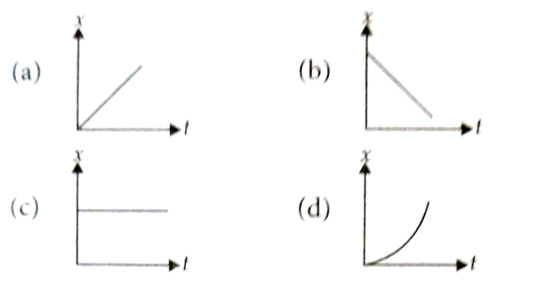
Q8. What does speedometer of a car measure?
a) Average speed.
b) Average velocity.
c) Instantaneous speed.
d) Instantaneous velocity.
Q9. Which of the following is true for a particle moving with uniform velocity –
a) Speed is zero.
b) Acceleration is zero.
c) Acceleration is opposite to the velocity.
d) Speed may be variable.
Q10. What does the adjacent graph tell you?
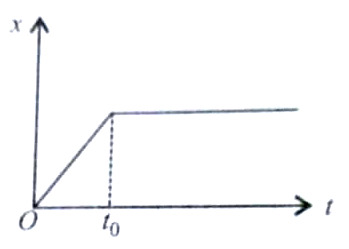
a) Particle is at rest.
b) Particle is continuously going along x-direction.
c) Velocity of the particle increases up to time \(t_0\) and then becomes constant.
d) Particle moves at a constant velocity up to a time \(t_0\) and then stops.
Q11. In the adjacent graph two different equal intervals of time are shown. If \(v_1\) and \(v_2\) are the average speed in time interval \(t_1\) and \(t_2\) respectively. Which of the following is correct?
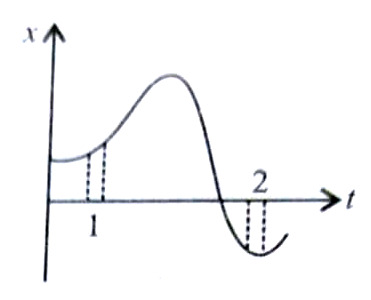
a) \(v_1\) > \(v_2\)
b) \(v_2\) > \(v_1\)
c) \(v_1\) = \(v_2\)
d) Insufficient data
Q12. Which of the following is incorrect for the adjacent graph? The graph is plotted for two children A and B returning from their school O to their homes P and Q.
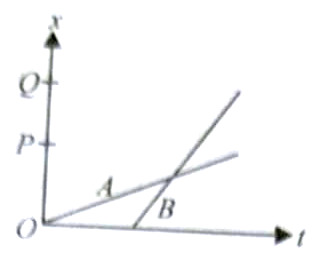
a) A lives closer to school than B.
b) A starts from the school earlier than B.
c) A walks faster than B.
d) A and B reach home at the same time.
Q13. In the adjacent graph, which point represents negative instantaneous velocity?
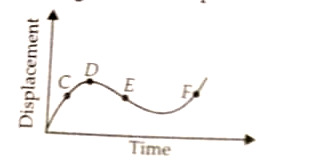
a) C
b) D
c) E
d) F
Q14. Which of the following graph does not represent one dimensional motion?
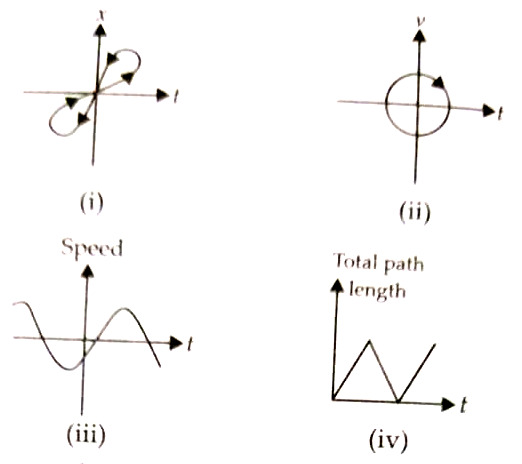
Q15. An object is moving such that displacement of the object is proportional to the cube of time elapsed. What would you expect for the acceleration of the object?
a) Increasing with time.
b) Decreasing with time.
c) Constant but not zero.
d) Zero.
Q16. What is revealed by the tangent drawn on velocity-time graph at any instant of time?
a) Acceleration.
b) Velocity.
c) Impulse.
d) Momentum.
Q17. What is represented by the area under acceleration-time graph?
a) Initial velocity.
b) Final velocity.
c) Change in velocity.
d) Distance traveled.
Q18. Which of the following is not correct –
a) X-t graph is a parabola if motion is uniformly accelerated.
b) V-t graph is a straight line inclined to the time-axis if motion is uniformly accelerated.
c) X-t graph is a straight line inclined to the time-axis if motions is uniform and acceleration is zero.
d) V-t graph is a parabola if motion is uniform and acceleration is zero.
Q19. A particle moves along a straight line with an acceleration \(a=p-qx\). P and q are constants. Particle starts from point A and stops at point B. What would be the maximum velocity of the particle?
a) \(p/q\)
b) \(p/\sqrt q\)
c) \(q/p\)
d) \(\sqrt q/p\)
Q20. Which of the following represents position-time graph for motion with zero acceleration?
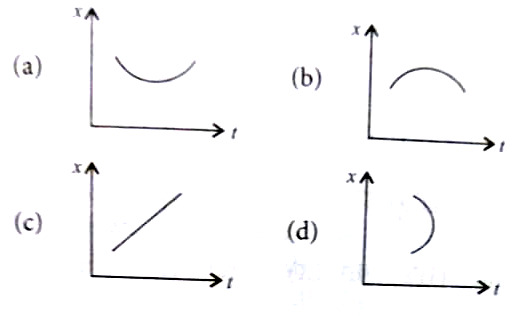
Q21. The adjacent graph represents velocity-displacement relation. Which of the following graph represents the variation of acceleration with displacement?
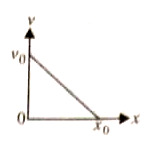
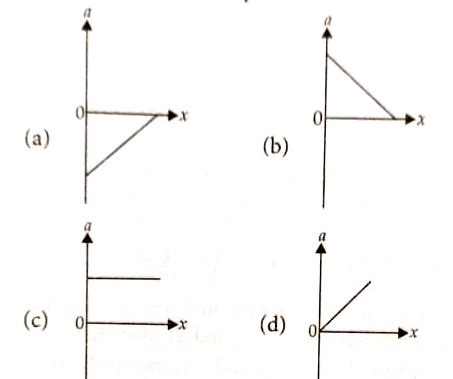
Q22. The adjacent graph represents velocity-time relation. Which of the following formula is correct for describing the motion of the particle over the time interval \(t_1\) to \(t_2\)?
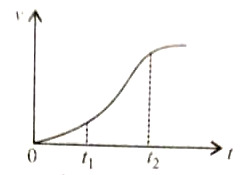
a)
b)
c)
d)
Q23. Which of the following curves describe the motion of a particle initially in positive direction with constant negative acceleration?
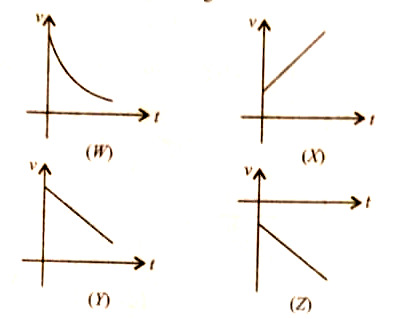
a) W
b) X
c) Y
d) Z
Q24. What situation is represented by the adjacent graph?
a) A cricket ball moving with a uniform speed is hit with a bat for a very short time interval.
b) A ball is falling freely from the top of a tower.
c) A car moving with constant velocity on a straight road.
d) A football is kicked into the air vertically upwards.
Q25. A body starts from rest and moves with a constant acceleration for t s. It travels a distance \(x_1\) in first half of time and \(x_2\) in next half of time. What would be the relation between \(x_1\) and \(x_2\)?
a) \(X_2\) = \(3x_1\)
b) \(X_2\) = \(x_1\)
c) \(X_2\) = \(4x_1\)
d) \(X_2\) = \(2x_1\)
Q26. What kind of motion is free fall?
a) A motion with uniform velocity.
b) A motion with uniform acceleration.
c) A motion with variable acceleration.
d) A motion with uniform speed.
Q27. Which of the following is not correct-
a) The zero velocity of a body at any instant does not necessarily imply zero acceleration at that instant.
b) The kinematic equation of motions are true only for motion in which the magnitude and the direction of acceleration are constants during the course of motion.
c) The sign of acceleration tells us whether the particles’ speed is increasingly or decreasing.
d) All of these.
Q28. Which series is formed by the distances covered by a freely falling body in its first, second, third,…,nth second?
a) Arithmetic progression
b) Geometric progression
c) No well defined series
d) Form a series corresponding to the difference of square root of the successive natural numbers.
Q29. A ball is thrown vertically upwards with velocity u. At highest point –
a) Both the velocity and acceleration of the ball are zero.
b) The velocity of the ball is u but its acceleration is zero.
c) The velocity of the ball is zero but its acceleration is g.
d) The velocity of the ball is u but its acceleration is g.
Q30. Stopping distance of a moving vehicle is directly proportional to –
a) Square of the initial velocity.
b) Square of the initial acceleration.
c) The initial velocity.
d) The initial acceleration.
Q31. An object is falling through a fluid. Its acceleration is given by a=g-bv. g is gravitational acceleration and b is a constant. After a long time of release the object is observed to fall with a constant speed. The speed is-
a) g/b
b) b/g
c) bg
d) b
Q32. A particle is released from rest from a tower of height 3h. The ratio of the intervals of time to cover three equal heights h is-
a) 3:2:1
b) \(1:(\sqrt2-1):(\sqrt3-2)\)
c) \(\sqrt3:\sqrt2:1\)
d) \(1:(\sqrt2-1):(\sqrt3-\sqrt2)\)
Q33. A stone is dropped from the top of a cliff. n seconds later another stone is thrown vertically downwards with a velocity u. The second stone overtakes the first. What distance below the top of the cliff this overtaking takes place?
a)
b)
c)
d)
Q34. A body starts from rest and then moves with a uniform acceleration. After n second the body acquires a velocity v. What is the displacement of the body in last 2 seconds?
a)
b)
c)
d)
Q35. A ball is thrown vertically upwards with speed u. At the same instant another ball B is released from rest at height h. At time t, the speed of A relative to B is-
a) u
b) \(u-2gt\)
c) \(\sqrt{u^2-2gh}\)
\(u-gt\)
Q36. Which of the following graph represents displacement-time graph of two objects A and B moving with zero relative velocity?
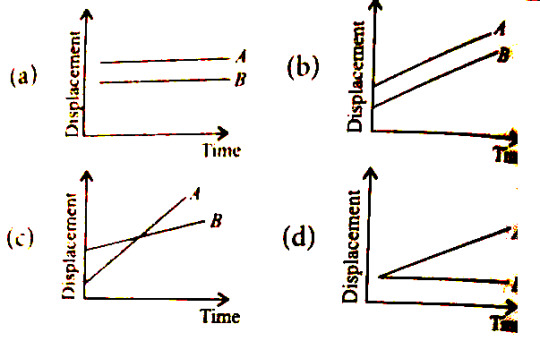
0 notes
Link
Ratio, Proportion and Variation - Concepts, Important Formulas, Formulas, Properties with Quantitative Aptitude Shortcuts & Tricks for all Competitive Exams
#ratio proportion and variation problems with solutions#What is Ratio#What is Proportion#What is Variation#Direct variations#Inverse variation#Impotent formulas and portieres of Ratios and Proportions
0 notes
Text
SSC CGL Syllabus 2021-22| Exam Pattern For Tier I, II,III,IV
Tier I Syllabus:
Tier-I: General Intelligence & Reasoning:
It would include questions of both verbal and non-verbal type. This component may include questions on analogies, similarities and differences, space visualization, spatial orientation, problem solving, analysis, judgment, decision making, visual memory, discrimination, observation, relationship concepts, arithmetical reasoning and figural classification, arithmetic number series, non-verbal series, coding and decoding, statement conclusion, syllogistic reasoning etc. The topics are, Semantic Analogy, Symbolic/ Number Analogy, Figural Analogy, Semantic Classification, Symbolic/ Number Classification, Figural Classification, Semantic Series, Number Series, Figural Series, Problem Solving, Word Building, Coding & de-coding, Numerical Operations, symbolic Operations, Trends, Space Orientation, Space Visualization, Venn Diagrams, Drawing inferences, Punched hole/ pattern- folding & un-folding, Figural Pattern- folding and completion, Indexing, Address matching, Date & city matching, Classification of centre codes/roll numbers, Small & Capital letters/ numbers coding, decoding and classification, Embedded Figures, Critical thinking, Emotional Intelligence, Social Intelligence, Other sub-topics, if any.
General Awareness:
Questions in this component will be aimed at testing the candidates‟ general awareness of the environment around him and its application to society. Questions will also be designed to test knowledge of current events and of such matters of every day observations and experience in their scientific aspect as may be expected of any educated person. The test will also include questions relating to India and its neighbouring countries especially pertaining History, Culture, Geography, Economic Scene, General Policy & Scientific Research.
Quantitative Aptitude:
The questions will be designed to test the ability of appropriate use of numbers and number sense of the candidate. The scope of the test will be computation of whole numbers, decimals, fractions and relationships between numbers, Percentage. Ratio & Proportion, Square roots, Averages, Interest, Profit and Loss, Discount, Partnership Business, Mixture and Alligation, Time and distance, Time & Work, Basic algebraic identities of School Algebra & Elementary surds, Graphs of Linear Equations, Triangle and its various kinds of centres, Congruence and similarity of triangles, Circle and its chords, tangents, angles subtended by chords of a circle, common tangents to two or more circles, Triangle, Quadrilaterals, Regular Polygons, Circle, Right Prism, Right Circular Cone, Right Circular Cylinder, Sphere, Hemispheres, Rectangular Parallelepiped, Regular Right Pyramid with triangular or square base, Trigonometric ratio, Degree and Radian Measures, Standard Identities, Complementary angles, Heights and Distances, Histogram, Frequency polygon, Bar diagram & Pie chart.
English Comprehension:
Candidates‟ ability to understand correct English, his/ her basic comprehension and writing ability, etc. would be tested.
Tier II Syllabus:
Paper-I (Quantitative Abilities):
The questions will be designed to test the ability of appropriate use of numbers and number sense of the candidate. The scope of the test will be the computation of whole numbers, decimals, fractions and relationships between numbers, Percentage, Ratio & Proportion, Square roots, Averages, Interest, Profit and Loss, Discount, Partnership Business, Mixture and Alligation, Time and distance, Time & Work, Basic algebraic identities of School Algebra & Elementary surds, Graphs of Linear Equations, Triangle and its various kinds of centres, Congruence and similarity of triangles, Circle and its chords, tangents, angles subtended by chords of a circle, common tangents to two or more circles, Triangle, Quadrilaterals, Regular Polygons, Circle, Right Prism, Right Circular Cone, Right Circular Cylinder, Sphere, Hemispheres, Rectangular Parallelepiped, Regular Right Pyramid with triangular or square base, Trigonometric ratio, Degree and Radian Measures, Standard Identities, Complementary angles, Heights and Distances, Histogram, Frequency polygon, Bar diagram & Pie chart.
Paper-II (English Language and Comprehension):
Questions in this component will be designed to test the candidate’s understanding and knowledge of English Language and will be based on spot the error, fill in the blanks, synonyms, antonyms, spelling/ detecting misspelled words, idioms & phrases, one word substitution, improvement of sentences, active/ passive voice of verbs, conversion into direct/ indirect narration, shuffling of sentence parts, shuffling of sentences in a passage, cloze passage & comprehension passage.
Paper-III (Statistics):
Collection, Classification and Presentation of Statistical Data – Primary and Secondary data, Methods of data collection; Tabulation of data; Graphs and charts; Frequency distributions; Diagrammatic presentation of frequency distributions.
Measures of Central Tendency- Common measures of central tendency – mean median and mode; Partition values- quartiles, deciles, percentiles.
Measures of Dispersion- Common measures dispersion – range, quartile deviations, mean deviation and standard deviation; Measures of relative dispersion.
Moments, Skewness and Kurtosis – Different types of moments and their relationship; meaning of skewness and kurtosis; different measures of skewness and kurtosis.
Correlation and Regression – Scatter diagram; simple correlation coefficient; simple regression lines; Spearman’s rank correlation; Measures of association of attributes; Multiple regression; Multiple and partial correlation (For three variables only).
Probability Theory – Meaning of probability; Different definitions of probability; Conditional probability; Compound probability; Independent events; Bayes‟ theorem.
Random Variable and Probability Distributions – Random variable; Probability functions; Expectation and Variance of a random variable; Higher moments of a random variable; Binomial, Poisson, Normal and Exponential distributions; Joint distribution of two random variable (discrete).
Sampling Theory – Concept of population and sample; Parameter and statistic, Sampling and non-sampling errors; Probability and nonprobability sampling techniques (simple random sampling, stratified sampling, multistage sampling, multiphase sampling, cluster sampling, systematic sampling, purposive sampling, convenience sampling and quota sampling); Sampling distribution (statement only); Sample size decisions.
Statistical Inference - Point estimation and interval estimation, Properties of a good estimator, Methods of estimation (Moments method, Maximum likelihood method, Least squares method), Testing of hypothesis, Basic concept of testing, Small sample and large sample tests, Tests based on Z, t, Chi-square and F statistic, Confidence intervals.
Analysis of Variance - Analysis of one-way classified data and two-way classified data.
Time Series Analysis - Components of time series, Determinations of trend component by different methods, Measurement of seasonal variation by different methods.
Index Numbers - Meaning of Index Numbers, Problems in the construction of index numbers, Types of index number, Different formulae, Base shifting and splicing of index numbers, Cost of living Index Numbers, Uses of Index Numbers.
Paper-IV (General Studies-Finance and Economics):
Part A: Finance and Accounts-(80 marks):
Fundamental principles and basic concept of Accounting:
Financial Accounting: Nature and scope, Limitations of Financial Accounting, Basic concepts and Conventions, Generally Accepted Accounting Principles.
Basic concepts of accounting: Single and double entry, Books of original Entry, Bank Reconciliation, Journal, ledgers, Trial Balance, Rectification of Errors, Manufacturing, Trading, Profit & loss Appropriation Accounts, Balance Sheet Distinction between Capital and Revenue Expenditure, Depreciation Accounting, Valuation of Inventories, Non-profit organisations Accounts, Receipts and Payments and Income & Expenditure Accounts, Bills of Exchange, Self-Balancing Ledgers.
Part B: Economics and Governance-(120 marks):
Comptroller & Auditor General of India- Constitutional provisions, Role and responsibility.
Finance Commission-Role and functions.
Basic Concept of Economics and introduction to Micro Economics: Definition, scope and nature of Economics, Methods of economic study and Central problems of an economy and Production possibilities curve.
Theory of Demand and Supply: Meaning and determinants of demand, Law of demand and Elasticity of demand, Price, income and cross elasticity; Theory of consumer’s behaviour Marshall an approach and Indifference curve approach, Meaning and determinants of supply, Law of supply and Elasticity of Supply.
Theory of Production and cost: Meaning and Factors of production; Laws of production- Law of variable proportions and Laws of returns to scale.
Forms of Market and price determination in different markets: Various forms of markets-Perfect Competition, Monopoly, Monopolistic Competition and Oligopoly ad Price determination in these markets.
Indian Economy:
Economic Reforms in India: Economic reforms since 1991; Liberalisation, Privatisation, Globalisation and Disinvestment.
Money and Banking:
Role of Information Technology in Governance.
Nature of the Indian Economy Role of different sectors Role of Agriculture, Industry and Services-their problems and growth;
National Income of India-Concepts of national income, Different methods of measuring national income.
Population-Its size, rate of growth and its implication on economic growth.
Poverty and unemployment- Absolute and relative poverty, types, causes and incidence of unemployment
Infrastructure-Energy, Transportation, Communication.
Monetary/ Fiscal policy- Role and functions of Reserve Bank of India; functions of commercial Banks/RRB/Payment Banks.
Budget and Fiscal deficits and Balance of payments.
Fiscal Responsibility and Budget Management Act, 2003.
Note: Questions in Paper-I will be of Matriculation Level, Paper-II of 10+2 Level and in Paper-III and Paper-IV of Graduation Level.
Tier-IV Syllabus (Skill Test):
Date Entry Skill Test (DEST):
The “Data Entry Speed Test” Skill Test will be conducted for a passage of about 2000 (two thousand) key depressions for a duration of 15 (fifteen) minutes.
Computer Proficiency Test (CPT):
The Commission will hold Computer Proficiency Test (CPT), comprising of three modules: (i) Word Processing, (ii) Spread Sheet and (iii) Generation of Slides. The CPT will be conducted in the manner decided by the Commission for the purpose. No exemption from CPT is allowed for any category of PwD candidates. CPT will be of qualifying nature.
SKILL LENS
Skill Lens is developed as an integrated technology-enabled platform to make learning (Shiksha) and Assessment (Sameeksha) happen simultaneously, finally get noticed by Skill Lens is developed as an integrated technology-enabled platform to make Learning (Shiksha) and Assessment (Sameeksha) happen simultaneously, finally get noticed by companies/recruiter (Pratibha).
Take IBPS Clerk mock tests: Once you have finished the entire syllabus, take our full-length IBPS Clerk mock tests and assess your performance. Identify your weak areas and work on them to improve.
Problem Solving Practice Tests
Verbal ability is a part of written tests in all the competitive examinations. Learn English and verbal ability with skill lens. We provide Video-Based Learning | Self Pace Study | Continuous Assessments. Subscribe now.
📲9490124655
💻skilllens.com
Like us fb.com/skilllens
Our Other Links: - t.me/skilllens, instagram.com/skilllens #skilllens #aptitude quiz #online quiz
0 notes
Link
Class 7 Mathematics Variation Class 7th chapter of mathematics Variation doubts is cleared by us. This chapter involves proportions of ratios, variations. This includes direct and inverse variations. Formulas related are included within this.
For more Details :- https://www.youtube.com/playlist?list=PLScxHn6ZIXlGX0okijimCrTaMZxrg-26Y
0 notes
Text
Scale/Proportion
Scale
Scale and proportion are related terms in that both basically refer to size. Scale is essentially another word for size. Large scale is a way of saying big and small scale mean small. Big and small however are related. What is Big? Big is meaningless unless we have some standard of reference. A big dog means nothing if we don’t know the size of most dogs. This is what separates the two terms. Proportion refers to relative size, size measured against other elements or against some mental norm or standard.
We often think of the word proportion and connection with mathematical systems of numerical ratios. It is true that historically many such systems have been developed. Artists have attempted to find the most pleasing size relationships in items as diverse as the width and length of sides of a rectangle to parts of the human body.
Scale and proportion are closely tied to emphasis and focal point. Large scale especially large scale and proportion to other elements, makes for an obvious visual emphasis.

Honore Sharrer, The Industiral Scene, center panel of Tribute to the American Working People, Oil on canvas, 25 x 31" 1945-50.
A dramatic juxtaposition in scale is made possible through montage of images. Think about how we collage found images together, weather through the cut and paste the photographs or digitized editing possible with the computer. this allows us to play with ideas of scale and proportion very easily.
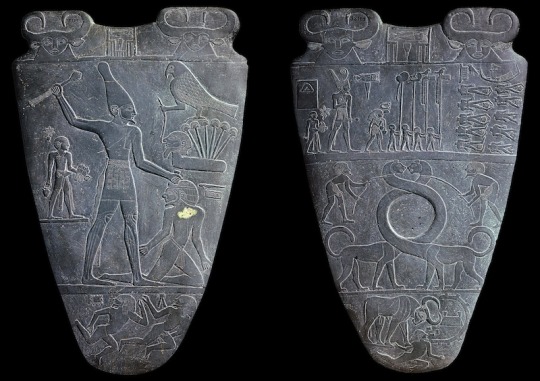
Palette Narmer
In past centuries visual scale was often related to thematic importance. The size of the figure was based on their symbolic importance in the subject being present. By making the most important person the largest in the composition, the artist immediately establishes not only an obvious focal point that indicates the relative conceptual status of that individual. this use the scale is called hieratic scaling.
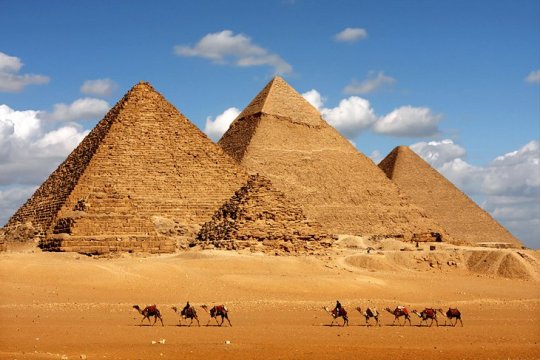
The gigantic pyramids made a political statement of the pharaohs eternal power.
Scale of Art
Human scale reference -
One way to think of artistic scale is to consider the scale of the work itself - It’s size in relationship to other art, in relationship to its surroundings, or in relationship to human size. Unhappily book illustrations, the internet, slides, social media, etc. cannot show art in its original size or scale. Unusual or unexpected scale as a rusty in an attention-getting. Sheer size does impress us.
Scale is the size of something compared to the world in general - an artwork might be termed miniature, small scale, full scale or life-size, large scale or larger than life, or monumental.
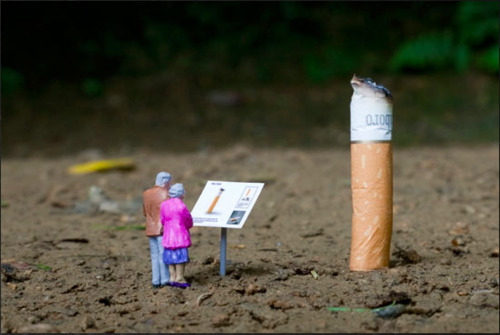
Miniature scale
Slinkachu - Relics, 2010
Monumental Scale
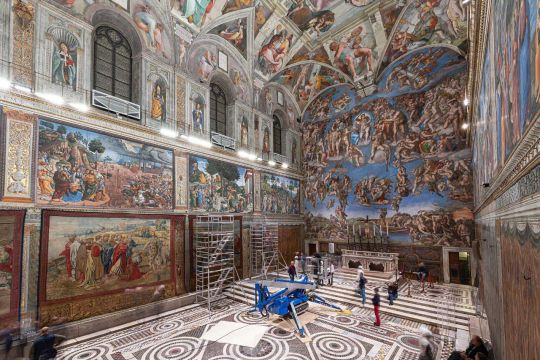
When we are confronted by Frescoes such as the Sistine Chapel ceiling, our first reaction is simply all at the enormous scope of the work. Later we study and admire details, but first we are overwhelmed with sheer magnitude. Works of art option selected or creative for specific locations, and their size and proportion to the setting is a prime consideration. A small religious painting appropriate for side chapel could be visually lost on the altar of a vast cathedral.

Earthworks are unique in the grandeur of their scale.
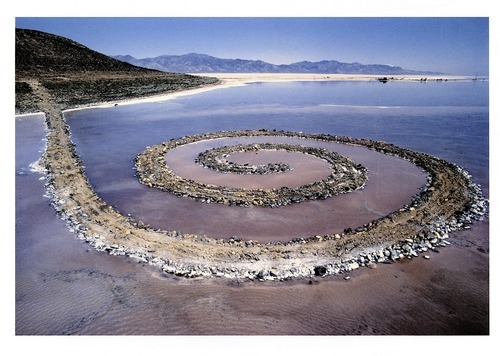
Robert Smithson - Spiral Jetty, 1970, mud, precipitated salt crystals, rocks, water, coil 1500’ long and 15’ wide
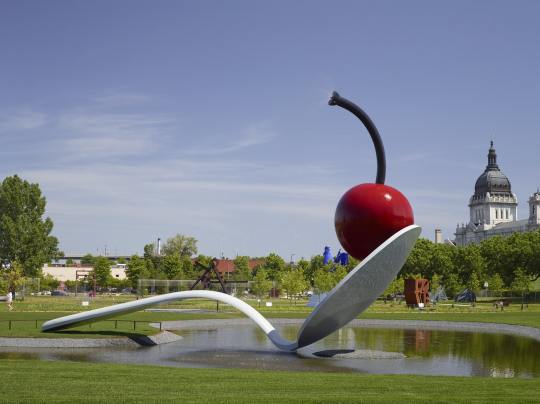
Claes Oldenburg has made use of a leap of scale and his “Spoonbridge and Cherry.” As with the work of other pop artist, the piece calls attention to an every day object not previously considered worthy of aesthetic consideration. Oldenburg transforms the object by elevating it to a monumental scale. A magnification such as this allows us to see the form with fresh eyes, and as a result we might discover new associations, such as the graceful arch of the of the spoon’s handle. It can also be argued that Oldenburg makes monuments appropriate to a consumer culture.
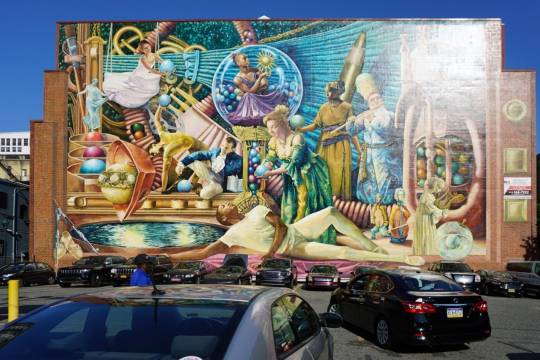
Naturalistic images blown up to such monumental scale cannot be ignored and they alter an urban environment.

Kent Twitchell, The Holy Trinity with the Virgin, acrylic wall painting, 40 x 56’ 1977-78.
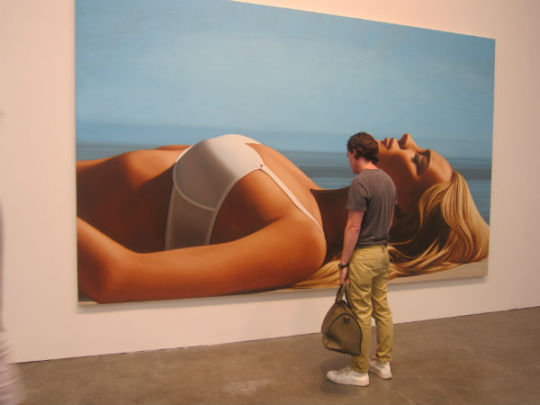



Look at the difference of scale can make an a painting.


Richard Phillips
Scale within Art
INTERNAL PROPORTIONS
The second way to discuss artistic scale is to consider the scale and size of elements within the design or pattern. The scale here, of course, is relative to the overall area of the format - A big element and one painting might be small and a large work. Again we often use the term proportion to describe the size relationship between various parts of a unit. Do you say an element in a composition is out of proportion and carries a negative feeling, and it is true that such a visual effect is often startling or unsettling. However, it is possible that this reaction is precisely what some artists desire.
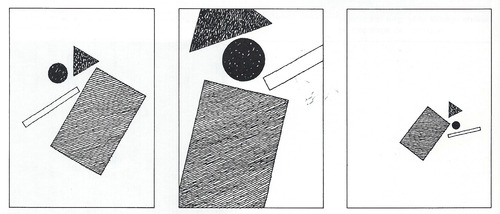
The three examples contains the same elements. But in each design the scale of the items is different, that’s altering the proportional relationship between the parts. This variation results in very different visual effects, in the same way that altering the proportions of ingredients in the recipe changes the final dish. which design is best or which we prefer can be argued. The answer would depend on what effect we wish to create.
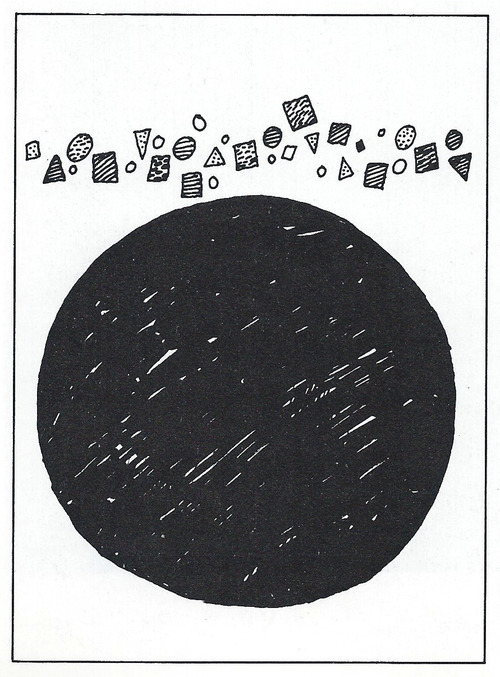
In the figure above the large black circle would certainly be called large scale. It is a large element and occupies much of the space, given the overall dimensions of the design. It can also be described as out of proportion. Compared to the other tiny elements it is too large and overwhelms the rest of the pattern, demanding all our visual attention.
CONTRAST OF SCALE
Scale can attract attention in different ways depending on the artist purpose. Scale can be used to draw our attention to unexpected or exaggerated, as when small objects are magnified or large ones reduced. Just the extreme change and scale attracts attention.
Unexpected skills often used in advertising. The visual attention can be directed to a product, we regularly see layouts with a large package, cookie, automobile grill, or cereal Flake, for example. A sudden scale change surprises us and gets our attention. The use of larger small skills often employed and painting or design. However, a more common practice is to combine the two for dramatic contrast.
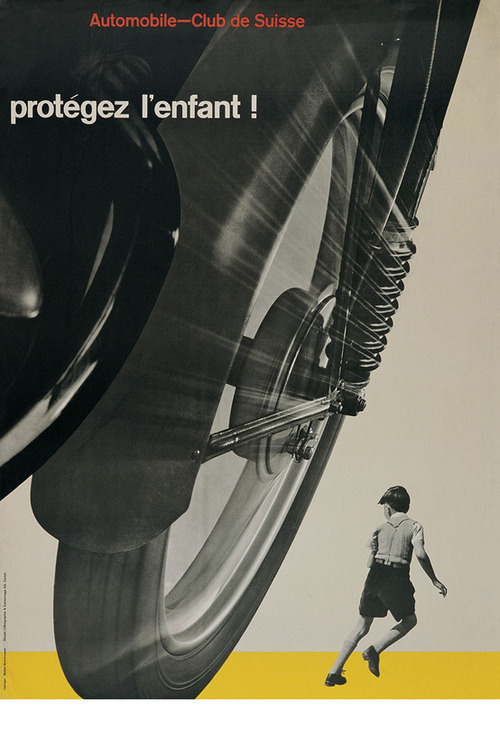
Josef Muller-Brockman, “Mind the Child”, poster, 1953
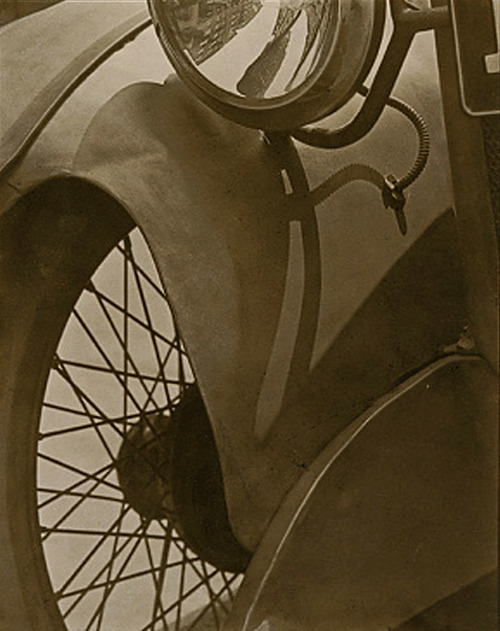
Paul Strand, Wheel 2 Mudguard, platinum print, 1917. Metropolitan Museum of Art, New York
Scale Confusion
The deliberate changing of natural scale is not unusual and painting. Some artists you scale changes intentionally to intrigue or mystify us rather than to clarify the focal point. Surrealism is an art form based on Paradox, on images I cannot be explained and rational terms. Artist who work in this manner present the irrational world of the dream or nightmare - recognizable elements in impossible situations.

Urbanized movie poster
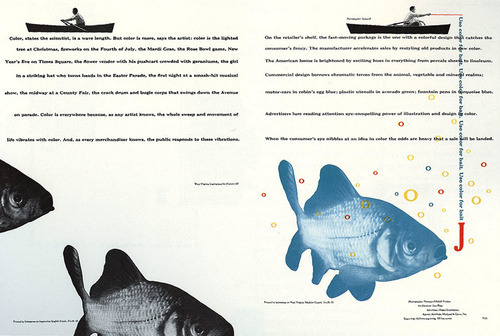
Bradbury Thompson, Westvaco Inspirations, magazine double paper, 1949
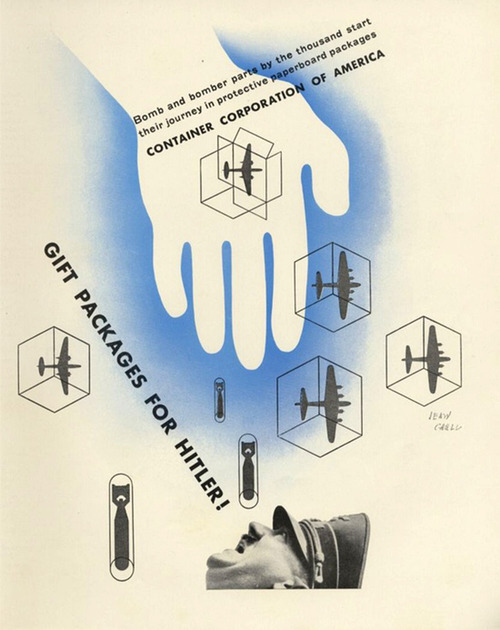
Jean Carlu, Gift package for Hitler, CAA Advertisement 1943

Rene, Magritte, “Personal Values” 1952, Oil Painting.
The Magritte painting shows one such enigma, with much of the mystery stemming from a confusion of scale. we identify the various elements easily enough, but they are all the wrong size and strange in proportion to each other. Does the painting show an impossibly large comb, shaving brush, bar soap, and other items, or are these items normal size but placed in a dollhouse room? Neither explanation makes rational sense.
Proportion
Proportion is the relationship of sizes between different parts of a work. For example, how wide it is compared to how tall it is. Some proportions, such as the golden ratio and the rule of thirds, are thought to be more naturally pleasing.
NOTIONS OF THE IDEAL
Proportion is linked to ratio that is just say we judge the proportions of some thing to be corrected the ratio of one element to another is correct. For example, the ratio of a babies head size to its body size is in proportion for an infant, but would strike us as out of proportion for an adult. In a life drawing class you might learn that in adult is about 7 1/2 has top. Formulas for the ideal figure have at times had the authority of a rule or Canon. Contemporary art or design seldom seems based on such cannons, but you may have noticed the apparent standard of 10 heads tall in an exaggerated proportion of fashion illustration.
The agent Greeks had a desire to discover ideal proportions, and these took the form of mathematical ratios. They found the perfect body to be seven headstall and even idealize the proportions of the parts of the body. In similar fashion they saw perfect proportions and rectangles employed in architectural design. Among these rectangles the one most often cited as perfect one is the golden rectangle. Well this is certainly a subjective judgment, the golden rectangle has Influenced Art and design throughout this is seceding centuries. The fact that this proportion is found in growth patterns in nature and lens itself to a modular repetition has given it some authority in the histories of design.
The Golden Ratio, Section, Mean, Rectangle, Spiral, Etc.
The golden ratio is a recurring relationship found in math, art and nature, and is thought by many to be inherently aesthetically pleasing. A number of contemporary artists and architects use the proportions of the golden ratio. These proportions do not provide a formula for design success. As with other visual principles, the attributes of the golden ration offer an option for design exploration.
In its many forms it boils down to approximately 1.618: a rectangle with dimensions 1 x 1.62 could be called a golden rectangle. More elegantly and interestingly expressed, two quantities,
a and b, are in the golden ration if a is to b as a + b is to a.
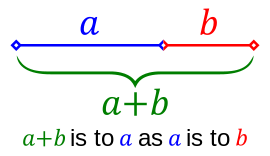

The golden ratio is said to be the basis of the proportions of many works of art and architecture, including most famously the Parthenon. However, like conspiracy theories, once you start looking for golden ratios, you can find them everywhere. Whether the artist intentionally employed the ratio, and whether it helps make the work more aesthetically pleasing, can sometimes be open to debate.
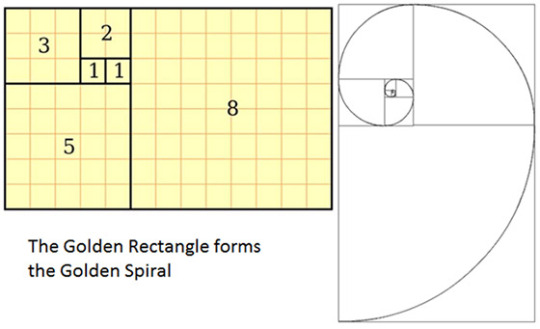
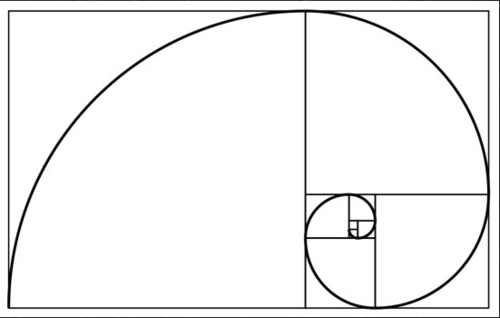
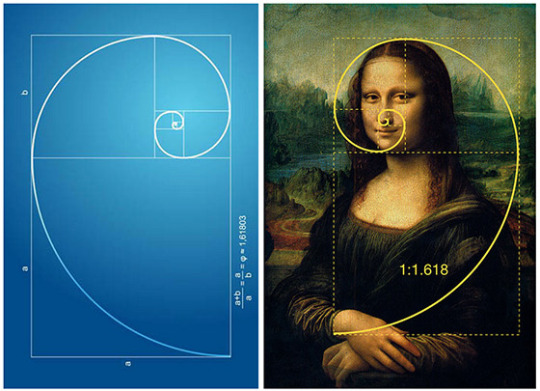
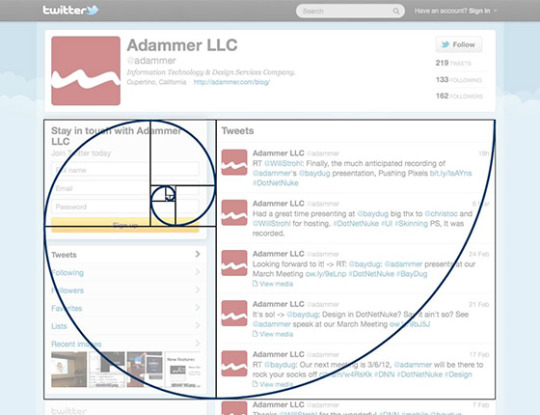
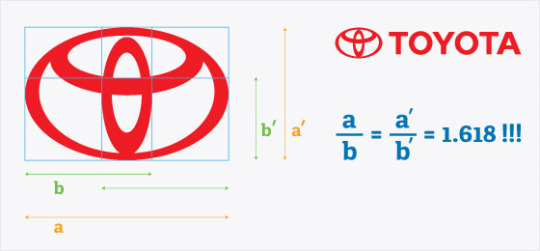
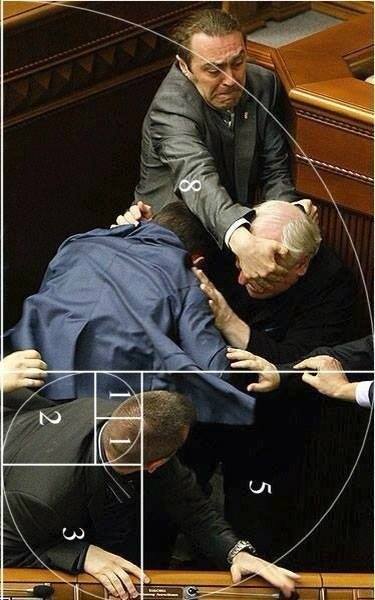
Golden ratio graph over image of a fight that broke out in Australia’s parliament.
The Rule Of Thirds
As a compositional rule of thumb, the rule of thirds states that it’s a good idea to imagine the picture plane divided into thirds horizontally and vertically, and then to align or place compositional elements along these guidelines or at their intersections. Placing the subject off-center and the horizon at the upper or lower third creates a more interest and can invite the viewer to look at more of the picture. If the subject is at the center, it can be more confrontational and in-your-face, and more formally balanced and static. The same idea may be applied to three-dimensional art. Good artists will neither slavishly follow this rule nor automatically center everything in the middle of the canvas or viewfinder: rather, they will consider what they want to convey, experiment with their subject, and then choose the composition and proportions that best help express their intent.
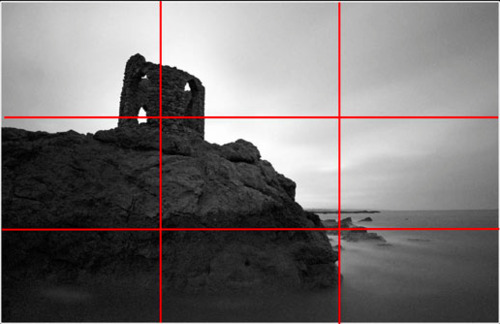
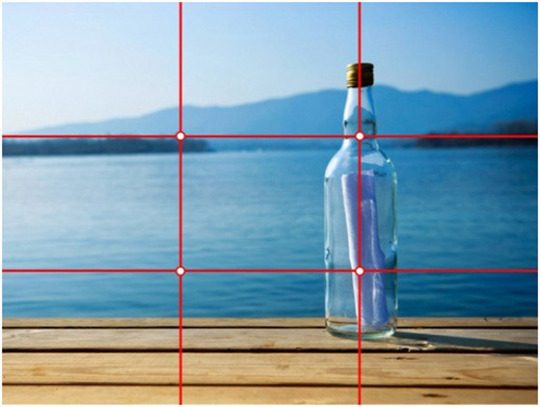

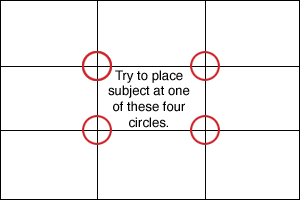
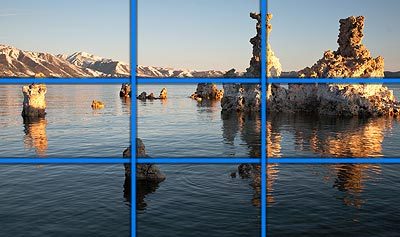
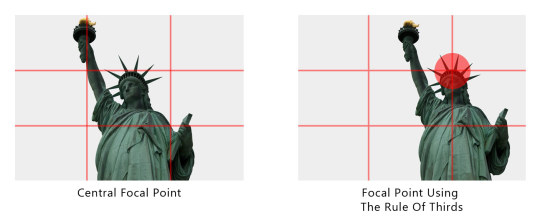
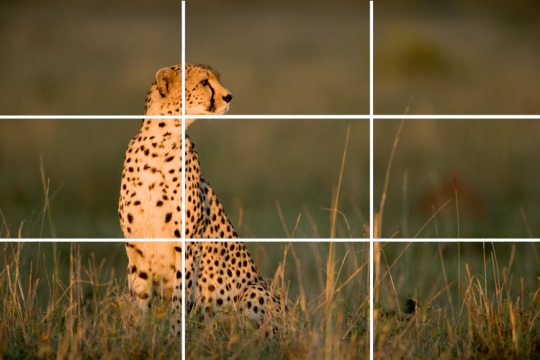
Class Exercise:
Scale, Proportion, & Ratio in Ads & Images (Written assignment) Find 2 ads or images (found or taken) that utilize the 1. rule of thirds and 2. The Golden Ratio/Spiral. You must use your Photoshop tools to help guide you. Overlay your grid or spiral and screen shot your work to upload to tumblr. Then provide a written analysis of the ad's or image’s effectiveness. Written homework must be 250 words each. Post the images on your blog along with your written analysis.
Pertinent questions to ask about: how is scale/proportion used to attract our eye? Does the use of scale create urgency and how? What is placement doing? What is placed where? Analyze and describe any other kind of 2d design issue you think are important. Discuss any subtext that may be crucial to the ad’s or image’s effectiveness.
Homework
Scale and Proportion Advertisements Create 2 advertisement posters that utilize the various scale/proportion issues discussed in class. Posters must advertise exhibitions that you are participating in. One ad should be for a group show that you are participating in. The other must be a solo exhibition.
For the group show consider the list of artists or designers you will be exhibiting with and the premise/theme of the group show. Do your research. What artists have I given you or showed the class over the course of the semester that are similar to your work or interest you? Choose up to 5 artists you would like to show with.
The solo show advertisement, this can be for a gallery or museum exhibit and/or a retrospective of your works at some future date. For the solo show consider carefully the venue that you will show in. Do you research. Where you decide to show your work is important. Make sure you know what type of work the gallery or museum exhibits. The Metropolitan Museum of Art is very different than MoMA PS1 which is different than Vox Populi Gallery which is different than the Mutter Museum. Choose a city and then research the institutions. See which one makes sense for your show.
Requirements and Restrictions
Each ad must include several images or designs relevant to the ad.
Each poster must be at least 11x 8.5 inches.
It can be should be entirely digital in nature (you do not need to print your posters).






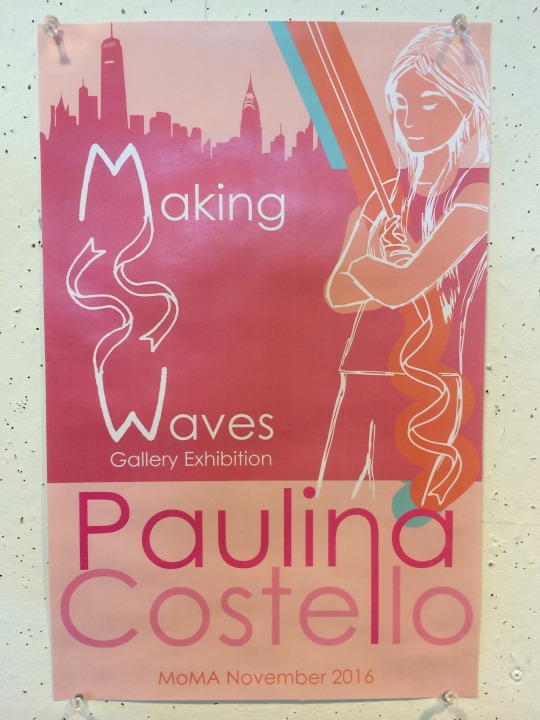
0 notes
Text
General Knowledge Question Answer | Set – 04
For cracking any competition exams, the general knowledge and current affairs are mandatory. General Knowledge is an essential part of any competitive exam, so we thought of a system that will help people in General Knowledge.
General Knowledge Question Answer
Q. The number of major languages, recognized in the Indian Union as the official language, is 22 Q. The oldest rocks in India are reported from Dharwar region, Karnataka Q. Which of the following groups of rivers originate from the Himachal mountains? Beas, Ravi, and Chenab Q. Which of the following groups of states has the largest deposits of iron ore? Bihar and Orissa Q. Which of the following union territories of India has the highest density of population per sq km? Delhi Q. Which atomic power station in India is built completely indigenously? Kalpakkam Q. The south-west monsoon contributes ____ of the total rain in India. 86% Q. The Shimla Convention is an agreement that sets Boundary between India and Tibet Q. The oldest oil field in India is the ____ field, in ____ Digboi, Assam Q. The oldest oil refinery in India is at Digboi, Assam Q. The oldest mountains in India are Aravalis Q. Which of the following groups of rivers have their source of origin in Tibet? Brahmaputra, Indus, and Sutlej Q. B. C. Roy Award is given in the field of Medicine Q. In which year was Pulitzer Prize established? 1917 Q. Gandhi Peace Prize for the year 2000 was awarded to the former President of South Africa along with Grameen Bank of Bangladesh Q. The prestigious Ramon Magsaysay Award was conferred upon Ms. Kiran Bedi for her excellent contribution to which of the following fields? Government Service Q. Which of the following societies has instituted an award for an outstanding parliamentarian? G. B. Pant Memorial Society Q. Which is the highest gallantry award in India? Param Vir Chakra Q. Which state gives Mewar award? Rajasthan Q. Who is the first Asian Winner of the Nobel Prize? Rabindranath Tagore Q. The first Indian to receive Noble Prize in Literature was Rabindranath Tagore Q. The first recipient of Rajiv Gandhi’s ‘Khel Ratna’ award is Vishwanathan Anand Q. Pulitzer prize is awarded for outstanding work in the field of Literature and Journalism Q. Saraswathi Samman is given annually for outstanding contribution to the literature Q. What is the predominant type of Indian agriculture? subsistence agriculture Q. The Radcliffe line is a boundary between India and Pakistan Q. Which of the following has a potential for harnessing of tidal energy in India? Gulf of Cambay Q. The typical area of sal forest in the Indian peninsular upland occurs On the Malwa plateau Q. The state has the largest area of forest cover in India is Madhya Pradesh Q. The year ____ is called a Great Divide in the demographic history of India. 1921 Q. The only private sector refinery set up by Reliance Petroleum Ltd. is located at Jamnagar Q. The only state in India that produces saffron is Jammu and Kashmir Q. Three important rivers of the Indian subcontinent have their sources near the Mansarover Lake in the Great Himalayas. These rivers are Brahmaputra, Indus, and Sutlej Q. The zonal soil type of peninsular India belongs to Red soils Q. The northern boundary of the peninsular plateau of Indian runs parallel to the Ganga and the Yamuna from Rajmahal hills to a point near Delhi Q. Which of the following food grain crops occupies the largest part of the cropped area in India? Rice Q. The Paithan (Jayakwadi) Hydro-electric project, completed with the help of Japan, is on the river Godavari Q. The percentage of irrigated land in India is about 35 Q. The southernmost point of peninsular India, that is, Kanyakumari, is North of the Equator Q. The pass located at the southern end of the Nilgiri Hills in south India is called The Palghat gap Q. The principal copper deposits of India lie in which of the following places? Hazaribag and Singbhum of Bihar Q. The Yarlung Zangbo river, in India, is known as Brahmaputra Q. The Salal Project is on the river Chenab Q. The only zone in the country that produces gold is also rich in iron is Southern zone Q. The percentage of earth surface covered by India is 2.4 Q. The present forest area of India, according to satellite data, is Decreasing Q. India’s highest annual rainfall is reported at Mawsynram, Meghalaya Q. The refineries are Mathura, Digboi and Panipat are set up by Indian Oil Corporation Ltd. Q. The study of soils is called Pedology Q. The sediment deposited at the base of the glacier is called Till Q. The smallest division of geological time scale is Stage Q. The smallest state, population-wise, in the world is Vatican City Q. The shortest day (longest night) in the southern hemisphere is June 21 Q. The smallest glaciers are Mountain or Alpine glaciers Q. Which of the following is measured on the Richter scale? Intensity of earthquakes Q. The term used to describe the combined effect of all shortwave losses in Earth albedo Q. The study of day-to-day variations in weather called is called Meteorology Q. The soils whose parent material tend to be rich in sand are Spodosols Q. The second largest continent in the world is Africa Q. The temperature increases rapidly after Ionosphere Q. Which of the following is concerned with the study of characteristics, origin, and development of landforms? Geomorphology Q. The soils common to the southeastern USA are called Ultisols Q. The Suez canal connects the Mediterranean sea and the Red sea Q. The uppermost epoch of the Neogene period is the Pliocene epoch Q. The slow downslope movement of soil and sediment because of frost heaving and thawing is called Frost creep Q. The smallest country of the world is Vatican city Q. The smallest annual temperature range occurs in the Equatorial tropical climate zone Q. The short term variations of the atmosphere, ranging from minutes to months are called Weather Q. The tide produced as a consequence of the moon and the sun pulling the earth in the same direction is called Springtide Q. The tropical cyclones with maximum sustained surface winds of 33 ms are called Hurricane Q. The typical soil of the tropical region, formed by the weathering of laterite rock, which promotes leaching of the soil is Laterite soils Q. The troughs of the waves are where the jet stream of waves is closest to the Equator Q. The Palaeozoic era contains ____ periods. Six Q. The northern portion of the western coastal plain is called Konkan plain Q. The number of a topographic map is 47A/16/NW. Its scale must be 1 : 25,000 Q. The radiation belts are zones in space around the Earth, Jupiter, and Saturn Q. The periods of different eras are further divided into Stages Q. The production of wheat has increased mainly due to increase in yield per hectare Q. Which of the following is not a Kharif crop? Mustard Q. The shape of the earth is Oblate Spheroid Q. The tertiary winds on the north of the Alps (Europe) are called The foehn Q. The tropical easterlies wind lie at 0-30? latitude Q. The transport of warm air toward the poles and cold air toward the equator is due to the development of waves Q. The sulfites are a mineral group that contain one or more metallic elements in combination with the sulfate compound ____ SO4 Q. The names of the scientists, Newlands, Mendeleev, and Meyer are associated with the development of Periodic table of contents Q. The ridges of the waves are where the jet stream of waves closes to the Poles Q. The rate at the change of temperature is called Temperature Gradient Q. The obscuring of one celestial body by another, particularly that of the sun or a planetary satellite Eclipse Q. The river Sutlej, on which the Bhakra Dam has been built, originates from Rakas lake in Tibet Q. The process of destruction or dying of fronts is called Frontolysis Q. The Palaeozoic era starts at ____ million years ago and ends at ____ million years ago. 570, 225 Q. The reaction is carbonate and bicarbonate ions with mineral is called Carbonation Q. The process of particle detachment by moving glacial ice is called Plucking Q. Which of the following is concerned with the description and mapping of the main features of the universe? Cosmography Q. The process that creates the deep oceanic trenches is called Plate tectonics Q. The rainfall in the peninsular interior averages about 650 mm a year Q. The hardest form of carbon is Diamond Q. The most important ore of aluminum is Bauxite Q. The number of electrons presents in H+ is Zero Q. The hottest part of the gas flame is known as Non-luminous zone Q. The human body is made up of several chemical elements; the element present in the highest proportion (65%) in the body is Oxygen Q. The number of waves made by an electron moving in an orbit having a maximum magnetic quantum number is +3 4 Q. The National Chemical Laboratory is situated in Pune Q. The maximum number of covalent formed by nitrogen is 4 Q. The formula C6H5-CO-CH3 represents Acetophenone Q. The metal that is usually extracted from seawater is Mg Q. The inert gases are ____ in water Sparingly soluble Q. The molecular formula of phosphorous is P4 Q. The percentage of sun’s radiation reflected into space is about 36 percent Q. The progressive wave theory regarding of tides was put forth by William Whewell Q. The platform and the basement rock together form Craton Q. The planet with the maximum number of natural satellites (moons), so far discovered is Jupiter Q. The river Jordan drains into the Dead Sea Q. The ratio of land to ocean in the southern hemisphere is 1 to 4 Q. The polar diameter is ____ to the equatorial diameter. Less Q. The ratio of the weight of water vapor to the total weight of air (including the water vapor) is called Specific humidity Q. The process of soil development is called Pedogenesis Q. The Panama canal links North America with South America Q. The Rhine river of northern Europe empties into The North sea Q. The part of the earth and the thin layer of air above its surface, which support life on earth, are referred to as Biosphere The above information has been collected for various newspapers or Govt websites. We are not any Recruiter Agency or we do not hold any kind of Recruitment Process. So Job Finders are requested to go to the Official website of the Government Organization for more details. We are not liable for any kind of Misunderstanding or False information given by the third party Media Agency or Website. Railway Jobs In India Police Jobs in India Defense Jobs in India Research Jobs in India Teaching Jobs in India Bank Jobs in India Hospitality Jobs in India Central Government Jobs Check Exam Result Download Admit Card

Recent Government Job Vacancy
General Knowledge Question Answer | Set – 04
Posted: April 18, 2020 For cracking any competition exams, the general knowledge and current affairs are mandatory. General Knowledge is an essential part of any competitive exam, so we thought of a system that will help people in General Knowledge. Table of Contents hide 1 General Knowledge Question Answer 2 Recent Government Job Vacancy General Knowledge Question Answer 0 comments
OSCB Recruitment 2020 Apply Now – Free Job Alert
Posted: April 16, 2020 OSCB Recruitment 2020(Odisha State Cooperative Banks/Central Cooperative Banks) – 786 Banking Assistant, Assistant Manager & System Manger Are you looking for a government job? OSCB Recruitment Board has brought you the golden opportunity of the Banking Assistant, Assistant Manager & System Manager post. If you are interested, please read the information below regarding the OSCB 0 comments
BPSC Recruitment 2020 – 221 Civil Judge
Posted: April 15, 2020 BPSC Recruitment 2020 (Bihar Public Service Commission) – – 221 Civil Judge Are you looking for a government job? BPSC Recruitment Board has brought you the golden opportunity of the Civil Judge post. If you are interested, please read the information below regarding the BPSC Recruitment Board rules carefully. Get all Free Job Alert Click 0 comments
TNEB Recruitment – 2900 Field Assistant (Trainee)
Posted: April 14, 2020 TNEB Recruitment (Tamil Nadu Electricity Board Limited) – 2900 Field Assistant (Trainee) Are you looking for a government job? TNEB Recruitment Board has brought you the golden opportunity of the Field Assistant (Trainee) post. If you are interested, please read the information below regarding the TNEB Recruitment Board rules carefully. Get all Free Job Alert 0 comments
HPSSC Recruitment 2020 Apply Now – Free Job Alert
Posted: April 14, 2020 HPSSC Recruitment 2020 (Himachal Pradesh Staff Selection Commission) – 943 TGT, Computer assistant, Steno, Pharmacist, Various posts Are you looking for a government job? HPSSC Recruitment Board has brought you the golden opportunity of the Computer assistant, Steno, Pharmacist, Various posts. If you are interested, please read the information below regarding the HPSSC Recruitment Board 0 comments Read the full article
#allindiagovtjob#currentjobvacancy#freejobalert#freejobalert2020#freejobalertssc#freeejobalert#GeneralKnowledge#GeneralKnowledgeQuestionAnswer#governmentjobs#govtjobalert#govtjobinindia#govtjobvacancy#govtjobstoday#govtjobswebsite#jobvacancy#latestgovtjob#latestgovtjobs#QuestionAnswer#RecentJobNotice#sarjarinaukri#sarkarijob#sarkariresult#vacancyjob#vacancyjob.in
0 notes
Text
300+ TOP Concrete Technology Questions and Answers
Concrete Technology Questions :-
1. Concrete grows with age. This statement is (a) true (b) false (c) debatable (d) given by Duff Abrams 2. Concrete in the structural member has to pass through (a) plastic stage (b) hardened stage (c) both (a) and (b) above (d) neither (a) nor (b) 3. Separation of the coarse aggregate from mortar is called (a) bleeding (b) segregation (c) compaction (d) none of the these

Concrete Technology Questions 4. The ease with which concrete can be compacted fully without segregation is called (a) bleeding (b) segregation (c) workability (d) none of these 5. Segregation can be prevented by (a) properly grading the aggregate (b) controlling water content in a mix (c) using correct handling procedures (d) all the above Concrete Technology Objective Questions Pdf Free Download :: 6. Separation of cement paste from sand in the mortar allowing the water or cement paste to appear at the surface is called (a) bleeding (b) segregation (c) honeycombing (d) none of these 7. Consider the following statements Sand in mortar is needed for 1. decreasing the quantity of cement 2. reducing shrinkage 3. decreasing the surface area of the binding material 4. increasing the strength Of these statements (a) 2,3, and 4 are correct (b) 1,2 and 3 are correct (c) 1,3 and 4 are correct (d) 1,2 and 4 are correct 8. Bleeding can be prevented by (a) controlling water content (b) using finely ground cement (c) controlling compaction (d) all the above 9. Bleeding of concrete may be due to 1. excess of water 2. too much finishing 3. coarse aggregates (a) 1 and 2 only (b) 2 and 3 only (c) 1 and 3 only (d) 1,2 and 3 10. The approximate value of the ratio between direct tensile strength and flexural strength is a) 0.33 b) 0.5 c) 0.75 d) 1.0 Ans: b 11. Strength of concrete increases with a) increase in water-cement ratio b) increase in fineness of cement c) decrease in curing time d) decrease in size of aggregate Ans: b 12. The relation between modulus of rupturefcr and characteristic strength of concrete fck is given by a) fcr=0.35Vf7 b) fcr=0.57f7 c) fcr=0.7Vf7 d) fcr=1.2Vf7 where fcr and fck are in N/mm2' Ans: c 13. The compressive strength of 100 mm cube as compared to 150 mm cube is always a) less b) more c) equal d) none of the above Ans: b 14. According to IS : 456 -1978, the modulus of elasticity of concrete Ec (in N/mm2) can be taken as a) Ec = = 5700 b) Ec = = 570 c) Ec = = 5700fck d) Ec = where fck N/mm2 = 700 is the characteristic strength in Ans: a 15. Increase in the moisture content in con-crete a) reduces the strength b) increases the strength c) does not change the strength d) all of the above Ans: a 16. As compared to ordinary portland cement, use of pozzuolanic cement a) reduces workability b) increases bleeding c) increases shrinkage d) increases strength Ans: c 17. Admixtures which cause early setting, and hardening of concrete are called a) workability admixtures b) accelerators c) retarders d) air entraining agents Ans: b 18. The most commonly used admixture which prolongs the setting and hardening time is a) gypsum b) calcium chloride c) sodium silicate d) all of the above Ans: a 19. The percentage of voids in cement is approximately a) 25% b) 40% c) 60% d) 80% Ans: b 20. The strength of concrete after one year as compared to 28 days strength is about a) 10 to 15% more b) 15 to 20% more c) 20 to 25% more d) 25 to 50% more Ans: c 21. As compared to ordinary portland cement, high alumina cement has a) higher initial setting time but lower final setting time b) lower initial setting time but higher final setting time c) higher initial and final setting times d) lower initial and final setting times Ans: a 22. Modulus of rupture of concrete is a measure of a) flexural tensile strength b) direct tensile strength c) compressive strength d) split tensile strength Ans: a 23. In order to obtain the best workability of concrete, the preferred shape of aggregate is a) rounded b) elongated c) angular d) all of the above Ans: a 24. The effect of adding calcium chloride in concrete is i) to increase shrinkage ii) to decrease shrinkage iii) to increase setting time iv) to decrease setting time The correct answer is a) (i) and (iii) b) (i)and(iv) c) (ii) and (iii) d) (ii) and (iv) Ans: b 25. Bulking of sand is maximum if moisture content is about a) 2 % b) 4% c) 6% d) 10% Ans: b 26. Finer grinding of cement a) affects only the early development of strength b) affects only the ultimate strength c) both (a) and (b) d) does not affect the strength Ans: a 27. Poisson's ratio for concrete a) remains constant b) increases with richer mixes c) decreases with richer mixes d) none of the above Ans: b 28. 1% of voids in a concrete mix would reduce its strength by about a) 5% b) 10 % c) 15% d) 20% Ans: a 29. The fineness modulus of fine aggregate is in the range of a) 2.0 to 3.5 b) 3.5 to 5.0 c) 5.0 to 7.0 d) 6.0 to 8.5 Ans: a 30. The factor of safety for a) steel and concrete are same b) steel is lower than that for concrete c) steel is higher than that for concrete d) none of the above Ans: b 31. Examine the following statements : i) Factor of safety for steel should be based on its yield stress, ii) Factor of safety for steel should be based on its ultimate stress, iii) Factor of safety for concrete should be based on its yield stress, iv) Factor of safety for concrete should be based on its ultimate stress. The correct statements are a) (i) and (iii) b) (i)and(iv) c) (ii) and (iii) d) (ii) and (iv) Ans: b 32. For a reinforced concrete section, the shape of shear stress diagram is a) wholly parabolic b) wholly rectangular c) parabolic above neutral axis and rectangular below neutral axis d) rectangular above neutral axis and parabolic below neutral axis Ans: c 33. Diagonal tension in a beam a) is maximum at neutral axis b) decreases below the neutral axis and increases above the neutral axis c) increases below the neutral axis and decreases above the neutral axis d) remains same Ans: c 34. If a beam fails in bond, then its bond strength can be increased most economi-cally by a) increasing the depth of beam b) using thinner bars but more in number c) using thicker bars but less in number d) providing vertical stirrups Ans: b 35. If nominal shear stress tv exceeds the design shear strength of concrete xc, the nominal shear reinforcement as per IS : 456-1978 shall be provided for carrying a shear stress equal to a) xv b) xc c) xv - TC d) Tv + Tc Ans: c 36. If the depth of actual neutral axis in a beam is more than the depth of critical neutral axis, then the beam is called a) balanced beam b) under-reinforced beam c) over-reinforced beam d) none of the above Ans: c 37. If the depth of neutral axis for a singly reinforced rectangular section is represented by kd in working stress design, then the value of k for balanced section a) depends on as, only b) depends on aCbC only c) depends on both crst and acbc d) is independant of both ast and acbc where d is the effective depth, ast is per-missible stress in steel in tension and ocbc is permissible stress in concrete in bend¬ing compression. Ans: a 38. If the permissible stress in steel in tension is 140 N/mm2, then the depth of neutral axis for a singly reinforced rectangular balanced section will be a) 0.35 d b) 0.40 d c) 0.45 d d) dependent on grade of concrete also Ans: b 39. Modulus of elasticity of steel as per IS : 456-1978 shall be taken as a) 20 kN/cm2 b) 200 kN/cm2 c) 200kN/mm2 d) 2xl06N/cm2 Ans: c 40. Minimum grade of concrete to be used in reinforced concrete as per IS:456-1978 is a) M15 b) M20 c) M 10 d) M25 Ans: a 41. For concreting of heavily reinforced sections without vibration, the workability of concrete expressed as compacting factor should be a) 0.75-0.80 b) 0.80-0.85 c) 0.85 - 0.92 d) above 0.92 Ans: d 42. Maximum quantity of water needed per 50 kg of cement for M 15 grade of concrete is a) 28 litres b) 30 litres c) 32 litres d) 34 litres Ans: c 43. In case of hand mixing of concrete, the extra cement to be added is a) 5% b) 10% c) 15% d) 20% Ans: b 44. For walls, columns and vertical faces of all structural members, the form work is generally removed after a) 24 to 48 hours b) 3 days c) 7 days d) 14 days Ans: a 45. The individual variation between test strength of sample should not be more than a) ±5% of average b) ± 10% of average c) ± 15% of average d) ±20% of average Ans: c 46. One of the criteria for the effecvve width of flange of T-beam is bf =—+ bw +6Df 6 In above formula, l0 signifies a) effective span of T-beam b) distance between points of zero mo-ments in the beam c) distance between points of maximum moments in the beam d) clear span of the T-beam Ans: b 47. For a cantilever of effective depth of 0.5m, the maximum span to satisfy vertical deflection limit is a) 3.5 m b) 4 m c) 4.5 m d) 5 m Ans: a 48. For a simply supported beam of span 15m, the minimum effective depth to satisfy the vertical deflection limits should be a) 600 mm b) 750 mm c) 900 mm d) more than 1 m Ans: b 49. For a continuous slab of 3 m x 3.5 m size, the minimum overall depth of slab to satisfy vertical deflection limits is a) 50 mm b) 75 mm c) 100 mm d) 120 mm Ans: b 50. According to IS : 456-1978, the fiexural strength of concrete is a) directly proportional to compressive strength b) inversely proportional to compressive strength c) directly proportional to square root of compressive strength d) inversely proportional to square root of compressive strength Ans: c 51. According to IS : 456-1978, the cblumn or the strut is the member whose effective length is greater than a) the least lateral dimension b) 2 times the least lateral dimension c) 3 times the least lateral dimension d) 4 times the least lateral dimension Ans: c 52. According to IS : 456- 1978, minimum slenderness ratio for a short column is a) less than 12 b) less than 18 c) between 18 and 24 d) more than 24 Ans: a 53. Lap length in compression shall not be less than a) 15 4> b) 20 c) 24 (j) d) 30 (j) where (j) is diameter of bar Ans: c 54. The minimum cover in a slab should neither be less than the diameter of bar nor less than a) 10 mm b) 15 mm c) 25 mm d) 13 mm Ans: b 55. For a longitudinal reinforcing bar in a column, the minimum cover shall neither be less than the diameter of bar nor less than a) 15 mm b) 25 mm c) 30mm d) 40 mm Ans: d 56. The ratio of the diameter of reinforcing bars and the slab thickness is a) 1/4 b) 1/5 c) 1/6 d) 1/8 Ans: d 57. According to IS: 456-1978, the maximum reinforcement in a column is a) 2 % b) 4% c) 6 % d) 8 % Ans: c 58. The percentage of reinforcement in case of slabs, when high strength deformed bars are used is not less than a) 0.15 b) 0.12 c) 0.30 d) 1.00 Ans: b 59. Which of the following statements is incorrect ? a) Minimum cross sectional area of longitudinal reinforcement in a column is 0.8%. b) Spacing of longitudinal bars measured along the periphery of column should not exceed 300 mm. c) Reinforcing bars in a column should not be less than 12 mm in diameter. d) The number of longitudinal bars pro-vided in a circular column should not be less than four. Ans: d 60. Which of the following statements is incorrect ? a) Higher Vee-Bee time shows lower workability. b) Higher slump shows higher workability. c) Higher compacting factor shows higher workability. d) none of the above Ans: d 61. Minimum pitch of transverse reinforce¬ment in a column is a) the least lateral dimension of the member b) sixteen times the smallest diameter of longitudinal reinforcement bar to be tied c) forty-eight times the diameter of transverse reinforcement d) lesser of the above three values Ans: d 62. Maximum distance between expansion joints in structures as per IS : 456 - 1978 is a) 20 m b) 30 m c) 45 m d) 60 m Ans: c 63. A continuous beam is deemed to be a deep beam when the ratio of effective span to overall depth (1/D) is less than a) 1.5 b) 2.0 c) 2.5 d) 3.0 Ans: c 64. Critical section for shear in case of flat slabs is at a distance of a) effective depth of slab from periphery of column/drop panel b) d/2 from periphery of column/capital/ drop panel c) at the drop panel of slab d) at the periphery of column Ans:b 65. Minimum thickness of load bearing RCC wall should be a) 50 mm b) 100 mm c) 150 mm d) 200 mm Ans:b 66. If the storey height is equal to length of RCC wall, the percentage increase in strength is a) 0 b) 10 c) 20 d) 30 Ans: b 67. In reinforced concrete footing on soil, the minimum thickness at edge should not be less than a) 100 mm b) 150 mm c) 200 mm d) 250 mm Ans:b 68. The slab is designed as one way if the ratio of long span to short span is a) less than 1 b) between 1 and 1.5 c) between 1.5 and 2 d) greater than 2 Ans: d 69. Ratio of permissible stress in direct compression and bending compression is a) less than 1 b) between 1 and 1.5 c) between 1.5 and 2.0 d) greater than 2 Ans: a 70. A higher modular ratio shows a) higher compressive strength of con-crete b) lower compressive strength of concrete c) higher tensile strength of steel d) lower tensile strength of steel Ans:b 71. The average permissible stress in bond for plain bars in tension is a) increased by 10% for bars in compression b) increased by 25% for bars in compression c) decreased by 10% for bars in compression d) decreased by 25% for bars in com-pression Ans:b 72. The property of the ingredients to separate from each other while placing the concrete is called a) segregation b) compaction c) shrinkage d) bulking Ans: a 73. Workability of concrete is directly proportional to a) aggregate cement ratio b) time of transit c) grading of the aggregate d) all of above Ans: c 74. Workability of concrete is inversely pro¬portional to a) time of transit b) 'vater-cement ratio c) the air in the mix d) size of aggregate Ans: a 75. The main reason for providing number of reinforcing bars at a support in a simply supported beam is to resist in that zone a) compressive stress b) shear stress c) bond stress d) tensile stress Ans: c 76. Half of the main steel in a simply supported slab is bent up near the support at a distance of x from the centre of slab bearing where x is equal to a) 1/3 b) 1/5 c) 1/7 d) 1/10 where 1 is the span Ans:c 77. When shear stress exceeds the permissible limit in a slab, then it is reduced by a) increasing the depth b) providing shear reinforcement c) using high strength steel d) using thinner bars but more in number Ans: a 78. If the size of panel in a flat slab is 6m x 6m, then as per Indian Standard Code, the widths of column strip and middle strip are a) 3.0 m and 1.5 m b) 1.5 m and 3.0 m c) 3.0 m and 3.0 m d) 1.5 m and 1.5 m Ans:c 79. For a slab supported on its four edges with corners held down and loaded uniformly, the Marcus correction factor to the moments obtained by Grashoff Rankine's theory a) is always less than 1 b) is always greater than 1 c) can be more than 1 d) can be less than 1 Ans: a 80. The permissible diagonal tensile stress in reinforced brick work is a) about 0.1 N/mm2 b) zero c) 0.3 N/mm2 to 0.7 N/mm2 d) about 1.0 N/mm2 Ans: a 81. The limits of percentage p of the longitudinal reinforce-ment in a column is given by a) 0.15% to 2% b) 0.8% to 4% c) 0.8% to 6% d) 0.8% to 8% Ans: c 82. The minimum diameter of longitudinal bars in a column is a) 6 mm b) 8 mm c) 12 mm d) 16 mm Ans:c 83. The minimum cover to the ties or spirals should not be less than a) 15 mm b) 20 mm c) 25 mm d) 50mm Ans: c 84. The load carrying capacity of a helically reinforced column as compared to that of a tied column is about a) 5% less b) 10% less c) 5% more d) 10% more Ans:c 86. The diameter of ties in a column should be a) more than or equal to one fourth of diameter of main bar b) more than or equal to 5 mm c) more than 5 mm but less than one-fourth of diameter of main bar d) more than 5 mm and also more than one-fourth of diameter of main bar Ans: d 87. Due to circumferential action of the spiral in a spirally reinforced column a) capacity of column is decreased b) ductility of column reduces c) capacity of column is decreased but ductility of column increases d) both the capacity of column and ductility of column increase Ans: d 88. Maximum percentage reinforcement in case of slabs is limited to a) 2 b) 4 c) 6 d) 8 Ans: b 89. Which of the following R.C. retaining walls is suitable for heights beyond 6m? a) L-shaped wall b) T-shaped wall c) counterfort type d) all of the above Ans: c 90. For the design of retaining walls, the minimum factor of safety against overturning is taken as a) 1.5 b) 2.0 c) 2.5 d) 3.0 Ans: b 91. In counterfort type retaining walls i) the vertical slab is designed as a continuous slab ii) the heel slab is designed as a conti¬nuous slab iii) the vertical slab is designed as a cantilever iv) the heel slab is designed as a cantilever The correct answer is a) (i) and (ii) b) (i)and(iv) c) (ii) and (iii) d) (iii) and (iv) Ans:a 92. A T-shaped retaining wall mainly conssits of a) one cantilever b) two cantilevers c) three cantilevers d) four cantilevers Ans: c 93. In T-shaped R C. retaining walls, the main reinforcement in the stem is provided on a) the front face in one direction b) the front face in both directions c) the inner face in one direction d) the inner face in both directions Ans:c 94. The main reinforcement in the toe of a T- shaped R C. retaining wall is provided on i) top face parallel to the wall ii) top face perpendicular to the wall iii) bottom face paralleUo the wall iv) bottom face perpendicular to the wall The correct answer is a) only (ii) is correct b) (i) and (ii) are correct c) (iii) and (iv) are correct d) only (iv) is correct Ans: d 95. The temperature reinforcement in the vertical slab of a T-shaped R.C. retaining wall is a) not needed b) provided equally on inner and front faces c) provided more on inner face than on front face d) provided more on front face than on inner face Ans: d 96. The main reinforcement in the heel of a T-shaped R.C. retaining wall is provided on a) top face perpendicular to wall b) bottom face perpendicular to wall c) both top and bottom faces perpendi-cular to wall d) none of the above Ans: a 97. In a counterfort retaining wall, the main reinforcement is provided on the i) bottom face in front counterfort ii) inclined face in front counterfort iii) bottom face in back counterfort iv) inclined face in back counterEort The correct answer is a) (i) and (ii), b) (ii) and (iii) c) (i) and (iv) d) (iii) and (iv) Ans: c 98. In counterfort retaining walls, the main reinforcement in the stem at support is a) not provided b) provided only on inner face c) provided only on front face d) provided both on inner and front faces Ans: b 99. In the design of a front counterfort in a counterfort retaining wall, the main reinforcement is provided on i) bottom face near counterfort ii) top face near counterfort iii) bottom face near centre of span iv) top face near centre of span The correct answer is a) only (i) b) only (ii) c) both (i) and (iv) d) both (ii) and (iii) Ans: c 100. In a counterfort retaining wall, the main reinforcement in the stem at mid span is provided on a) front face only b) inner face only c) both front face and inner face d) none of the above Ans: a 101. The depth of footing for an isolated column is governed by i) maximum bending moment ii) shear force iii) punching shear The correct answer is a) only (i) b) (i)and(ii) c) (i) and (iii) d) (i), (ii) and (iii) Ans: d 102. If the foundations of all the columns of a structure are designed on the total live and dead load basis, then a) there will be no settlement of columns b) there will be no differential settlement c) the settlement of exterior columns will be more than interior columns d) the settlement of interior columns will be more than exterior columns Ans:c 103. To minimise the effect of differential settlement, the area of a footing should be designed for a) dead load only b) dead load + live load c) dead load + fraction of live load d) live load + fraction of dead load Ans: c 104. The critical section for finding maximum bending moment for footing under masonry wall is located a) at the middle of the wall b) at the edge of the wall c) halfway between the middle and edge of the wall d) at a distance equal to effective depth of footing from the edge of the wall Ans: c 105. In a pile of length /, the points of suspen¬sion from ends for lifting it are located at a) 0.207 1 b) 0.25 / c) 0.293 / d) 0.333 / Ans: a 106. During erection, the pile of length / is supported by a crane at a distance of a) 0.207 / b) 0.293 / c) 0.7071 d) 0.793 / from the driving end of pile which rests on the ground Ans: c 107. While designing the pile as a column, the end conditions are nearly a) both ends hinged b) both ends fixed c) one end fixed and other end hinged d) one end fixed and other end free Ans: c 108. The recommended value of modular ratio for reinforced brick work is a) 18 b) 30 c) 40 d) 58 Ans: c 109. According to ISI recommendations, the maximum depth of stress block for balanced section of a beam of effective depth d is a) 0.43 d b) 0.55 d c) 0.68 d d) 0.85 d Ans: a 110. Assertion A : The load factor for live load is greater than that for dead load. Reason R : The live loads are more uncertain than dead loads. Select your answer based on the coding system given below : a) Both A and R are true and R is the correct explanation of A. b) Both A and R are true but R is not the correct explanation of A. c) A is true but R is false. d) A is false but R is true. Ans: a 111. The centroid of compressive force, from the extreme compression fibre, in limit state design lies at a distance of a) 0.367 xu b) 0.416 xu c) 0.446 xu d) 0.573 xu where xu is the depth of neutral axis at the limit state of collapse Ans: b 112. The design yield stress of steel according to IS: 456-1978 is a) 0.37 fy b) 0.57 fy c) 0.67 fy d) 0.87 fy where fy is the characteristic yield strength of steel Ans: d 113. According to Whitney's theory, ultimate strain of concrete is assumed to be a) 0.03% b) 0.1% c) 0.3% d) 3% Ans: c 114. According to Whitney's theory, depth of stress block for a balanced section of a concrete beam is limited to a) 0.43 d b) 0.537 d c) 0.68 d d) 0.85 d where d is effective depth of beam Ans: b 115. The load factors for live load and dead load are taken respectively as a) 1.5 and 2.2 b) 2.2 and 1.5 c) 1.5 and 1.5 d) 2.2 and 2.2 Ans:b 116. As per Whitney's theory, the maximum moment of resistance of the balanced section of a beam of width b and effective depth d is given by a) ^acybd2 b) ^acybd2 c) 0.185acybd2 d) 0.43acybd2 where acy is the cylinder compressive strength of concrete Ans: b 127. The effect of creep on modular ratio is a) to decrease it b) to increase it c) either to decrease or to increase it d) to keep it unchanged Ans: b 128. Shrinkage of concrete depends upon i) humidity of atmosphere ii) passage of time iii) stress The correct answer is a) (i) and (ii) b) (ii) and (iii) c) only (iii) d) All (i), (ii) and (iii) Ans: a 129. Due to shrinkage stresses, a simply supported beam having reinforcement only at bottom tends to a) deflect downward b) deflect upward c) deflect downward or upward d) none of the above Ans: a 130. In symmetrically reinforced sections, shrinkage stresses in concrete and steel are respectively a) compressive and tensile b) tensile and compressive c) both compressive d) both tensile Ans: b 131. A beam curved in plan is designed for a) bending moment and shear b) bending moment and torsion c) shear and torsion d) bending moment, shear and torsion Ans: d 132. In a spherical dome subjected to concentrated load at crown or uniformly distributed load, the meridional force is always a) zero b) tensile c) compressive d) tensile or compressive Ans: c 133. Sinking of an intermediate support of a continuous beam i) reduces the negative moment at support ii) increases the negative moment at support iii) reduces the positive moment at centre of span iv) increases the positive moment at centre of span The correct answer is a) (i) and (iii) b) (i)and(iv) c) (ii) and (iii) d) (ii) and (iv) Ans: b 134. The maximum value of hoop compression in a dome is given by a) wR / 4d b) wR/2d c) wR/d d) 2wR/d where, w = load per unit area of surface of dome R = radius of curvature d = thickness of dome Ans: b 135. In a spherical dome the hoop stress due to a concentrated load at crown is a) compressive everywhere b) tensile everywhere c) partly compressive and partly tensile d) zero Ans:b 136. In a ring beam subjected to uniformly distributed load i) shear force at mid span is zero ii) shear force at mid span is maximum iii) torsion at mid span is zero iv) torsion at mid span is maximum The correct answer is a) (i) and (iii) b) (i)and(iv) c) (ii) and (iii) d) (ii) and (iv) Ans:a 137. In prestressed concrete a) forces of tension and compression change but lever arm remains unchanged b) forces of tension and compressions remain unchanged but lever arm changes with the moment c) both forces of tension and compres-sion as well as lever arm change d) both forces of tension and compres-sion as well as lever arm remain unchanged Ans: b 138. The purpose of reinforcement in prestressed concrete is a) to provide adequate bond stress b) to resist tensile stresses c) to impart initial compressive stress in concrete d) all of the above Ans: c 139. Normally prestressing wires are arranged in the a) upper part of the beam b) lower part of the beam c) centre d) anywhere Ans: b 140. Most common method of prestressing used for factory production is a) Long line method b) Freyssinet system c) Magnel-Blaton system d) Lee-Macall system Ans:a 141. Select the incorrect statement a) The loss of prestress is more in pre-tensioning system than in post-tensioning system. b) Pretensioning system has greater certainty about its durability. c) For heavy loads and large spans in buildings or bridges, post-tensioning system is cheaper than pretensioning system d) none of the above Ans:d 142. Which of the following losses of prestress occurs only in pretensioning and not in post-tensioning ? a) elastic shortening of concrete b) shrinkage of concrete c) creep of concrete d) loss due to friction Ans: a 143. Prestress loss due to friction occurs a) only in post-tensioned beams b) only in pretensioned beams c) in both post-tensioned and preten-sioned beams d) none of the above Ans:a 145. Which of the following has high tensile strength ? a) plain hot rolled wires b) cold drawn wires c) heat treated rolled wires d) all have same tensile strength Ans: b 146. High carbon content in the steel causes a) decrease in tensile strength but increase in ductility b) increase in tensile strength but decrease in ductility c) decrease in both tensile strength and ductility d) increase in both tensile strength and ductility Ans:b 147. Stress strain curve of high tensile steel a) has a definite yield point b) does not show definite yield point but yield point is defined by 0.1% proof stress c) does not show definite yield point but yield point is defined by 0.2% proof stress d) does not show definite yield point but yield point is defined by 2% proof stress, Ans: c 148. Select the correct statement a) Elastic modulus of high tensile steel is nearly the same as that of mild steel. b) Elastic modulus of high tensile steel is more than that of mild steel. c) Carbon percentage in high carbon steel is less than that in mild steel. d) High tensile steel is cheaper than mild steel. Ans:a 149. Cube strength of controlled concrete to be used for pretensioned and post-tensioned work respectively should not be less than a) 35 MPa and 42 MPa b) 42 MPa and 35 MPa c) 42 MPa and 53 MPa d) 53 MPa and 42 MPa Ans: b 150. Ultimate strength of cold drawn high steel wires a) increases with increase in diameter of bar b) decreases with increase in diameter of bar c) does not depend on diameter of bar d) none of the above Ans: b 151. In working stress design, permissible bond stress in the case of deformed bars is more than that in plain bars by a) 10% b) 20% c) 30% d) 40% Ans: d Concrete Technology Mcqs :: Read the full article
0 notes
Text
WHAT HAPPENS WHEN YOU CROSSOVER EVERY SINGLE CAR DESIGN
In what can be a completely insightful exercising for transportation designers, each us of a-particular and the world over, the men at NeoMam Studios have superimposed as many as 25 photos of cars within distinct, separate classes to create an image of “the common vehicle”. This amalgamation of fronts and rears is interesting as it sees no logo, it sees no charge, and it sees no cultural or finances constraints. All it's far, is a visual mash-up of multiple vehicles across multiple brands to create something homogeneous. The “average vehicle” collection does two exciting things. It A. Shows us what’s commonplace between automobiles of categories, and B. Shows us how a few manufacturers have also tried to be subtly exceptional. There’s a wonderful similarity in, for example, the taillight layout of a Pickup as opposed to a Sedan, or the grille on a Convertible versus the grille on a Crossover. It’s crucial for transportation designers to understand these similarities and variations in car designs, so that it’s a lot easier to interrupt the mould of layout and create some thing really new and daringly exclusive. Let’s check how those average cars look, and the way designers of the destiny can break this pattern of predictability.


The Average Pickup Pickups are the fine-selling motors in USA and are the strong backbone of Ford and GM’s commercial enterprise. Considering that essentially the whole international pickup market is US-targeted, it’s no surprise that size is the whole lot on the subject of the common front. The glossy traces of Japanese and European models, just like the Isuzu D-Max or Mercedes X-Class are toughened out with the more rugged, boxed look of the likes of the GMC Sierra and Chevy Silverado. The common rear of a pickup shows pretty some competing factors seeking to muscle thru. A complete rear-mild pillar on each facets wins out over more minimalist processes, like at the F-a hundred and fifty. The common pickup may also journey plenty better than might be predicted, sticking to its original operating automobile roots as opposed to happening the road of many modern variations which often appear more cause on looking like performance cars than carrying a load of stakes.

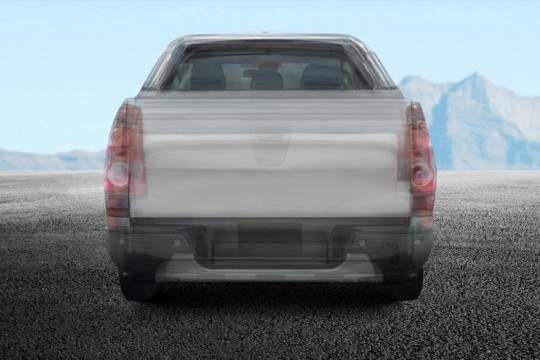
The Average UTE Where would we be without the liked UTE? The rest of the world considers them a piece of an anomaly but here at domestic they reign splendid, so much so that pretty much every producer selling in Australia gives a UTE model. With UTEs’ fronts ranging from compacts or saloons, just like the Jumbuck, to commercials just like the VW Caddy, all the manner to full on American-fashion pickups inside the mold of the HiLux, the common front is quite a combination of patterns. What wins out is the shape of lower riding saloon, however with sterner lines and a flattened bonnet giving its appearance a hint of American muscle. Though UTEs are all about birthday party at the front and business at the again, the average rear is tremendously heavy-duty, looking exactly like what a saloon/pickup cross ought to. There are recommendations of the facet bars and tarp and Tonneau cover helps that set UTEs aside from their American cousins however through the looks of things the average UTE might have carrying capacity to healthy any of them.

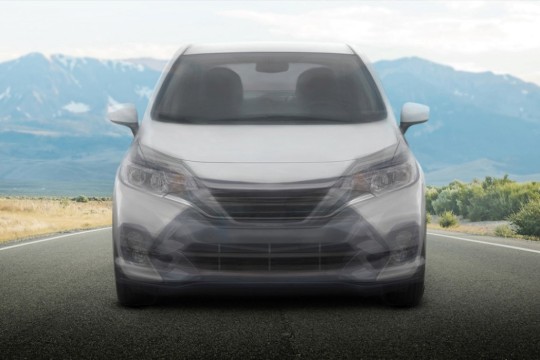
The Average Hatchback Though everyone may have their favorites for extraordinary motives, hatchbacks usually follow a formulaic pattern, which became why it became wonderful whilst some strong capabilities shone thru in spite of being averaged out. Its height to width ratio, as an instance, makes it lots taller than one might assume, which would recommend that producers had been quietly top notch-sizing hatchback fashions to meet current tastes while still striving for them to match into “small” automobile categories. This is also borne out within the bonnet length, that's in step with a smaller engine housing, however appears to be extraordinarily tiny as compared to the rest of the car’s dimensions. The common rear is also an eye fixed-opener for hatchback aficionados. Gone is the sporty fastback fashion of the mid-00s and in is a far greater reserved, Yaris-style instantly rear. Though that doesn’t mean that the sporty nature of hatchbacks has been absolutely eroded, the averaging out also gives you a twin exhaust machine to maintain the horsepower ticking over.


The Average Sedan The common sedan definitely seems to look something but average, displaying off a few slick lines and boasting a meaty radiator grille. The wraparound headlights are definitely on-factor and the bonnet suggests off a sweeping curve across the sides which follows the contemporary Japanese design trend from, amongst others, the new Subaru Legacy and Toyota Camry. So, even though the averaging methodology is completely goal, right here it’s clearly controlled to create some thing which could in shape proper in at any of the main shows. The rear of our common sedan takes a barely much less formidable and adventurous course. The boot and rear shoulders would extra befit a boxer than a ballet dancer however who’s to say that strong and uncompromising isn’t exactly what the common sedan driver is looking for. The rear intakes and dual exhausts upload a dash of aptitude however, common, it’s a solid, dependable look that wins out.


The Average SUV Sports utility cars or SUVs are a heavy-obligation lot which don’t genuinely recognize whether they need to be off-roaders or town-tractors. Due to this vehicular dysmorphia and the special layout directions taken by means of the numerous marques, we observed that the common SUV got here out with some captivating features. The front is stern, with an enforcing and barely sticking out nose and the type of grille that wouldn’t look out of region on a semi-truck. The average rear has very a great deal the advent of one of the original archetypes of the class, the Chevy Suburban. This elongated and box-like rear become initially to provide greater room on your camping equipment, however from the appearance of the common SUV we’ve created, they have got now end up the size of a small house.
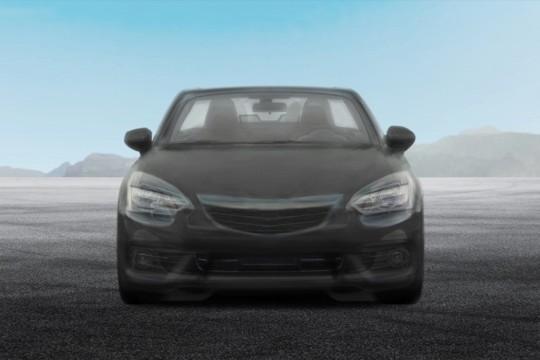
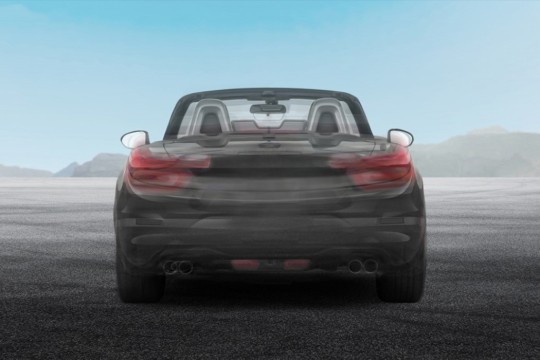
The Average Convertible As a fave of design groups who get to set free with traces, curves and features, each convertible is particular and so an interesting project for the averaging process. Drawing from Corvettes, Porsches, S-Classes and many more, the end result is that most of the kinks and curves are ironed out, although the auto still holds onto its low-profile person and the extra lower the front air intakes to preserve the probably souped-up powertrain chilled. The average rear but sincerely takes on some of the fine sporty features from the convertible magnificence. A quad exhaust system need to keep air flowing properly, at the same time as the drag-decreasing aerodynamic curves wouldn’t preserve the car again. The average convertible might obviously also have the hood down, what’s the factor in having a convertible otherwise.
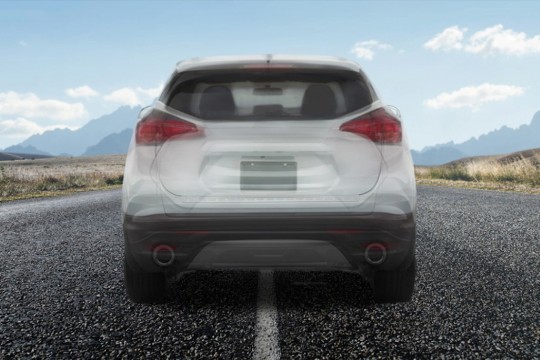

The Average Crossover Crossovers are already a significant mix of ideas, in that they generally proportion a design platform with smaller cars but get amped as much as be like milder variations of SUVs, so creating a median model acceptable it perfectly. This can be visible within the the front, wherein the narrowing curves across the headlights lead to a more tapered grille than the more in-your-face battering ram method of an SUV. The windscreen and upper element also are more petite than stated, aiming for substance in preference to declaration. The rear of the average crossover is also loads extra understated than the SUV however contains loads greater heft than the common sedan or hatchback, https://www.motortrend.com/concept-cars/even though it has a further low profile. It shows first-rate traces under the brake lighting and a graceful rear window design. Go ahead! Bookmark this newsletter for future reference because I know you designers out there can use this for future design inspiration. concept cars 2018, old concept cars, concept cars 2020, concept cars 2019, concept cars for sale, concept cars that made it to production, concept cars drawings, lamborghini concept cars Read the full article
#conceptcars2018#conceptcars2019#conceptcars2020#conceptcarsdrawings#conceptcarsforsale#conceptcarsthatmadeittoproduction#lamborghiniconceptcars#oldconceptcars
0 notes